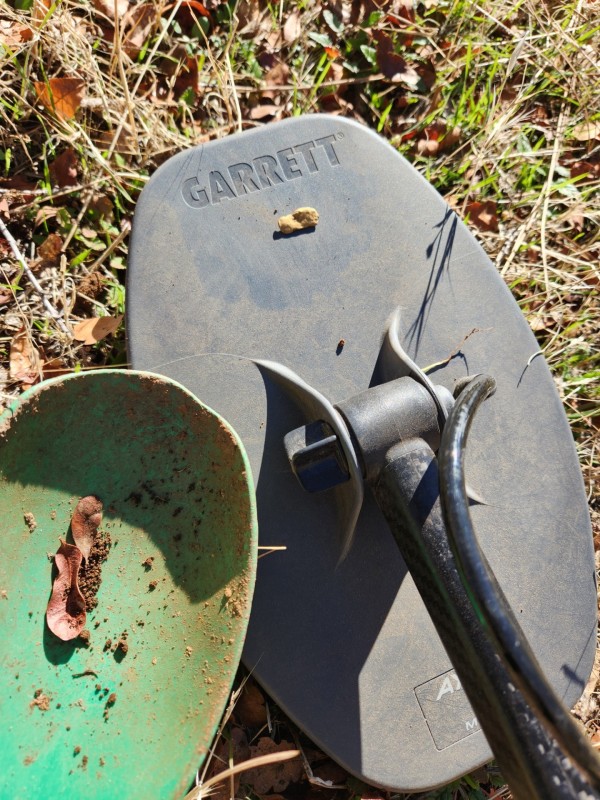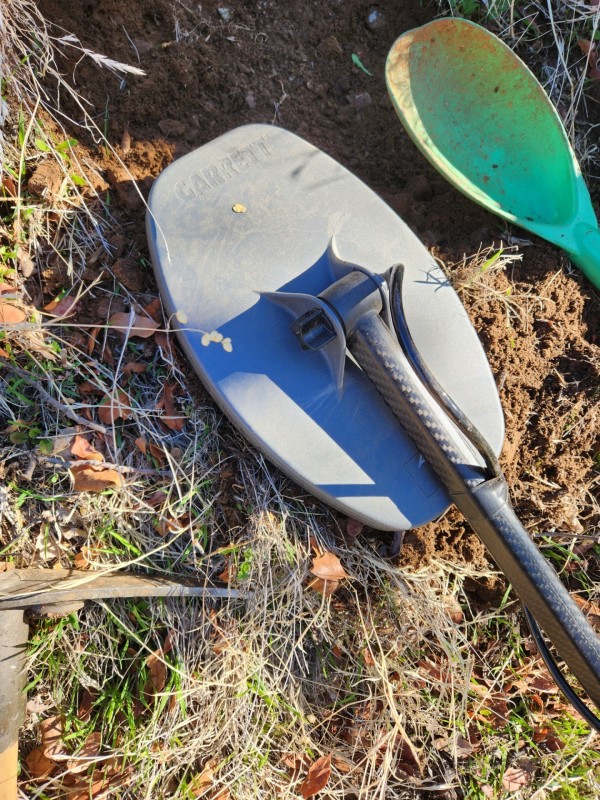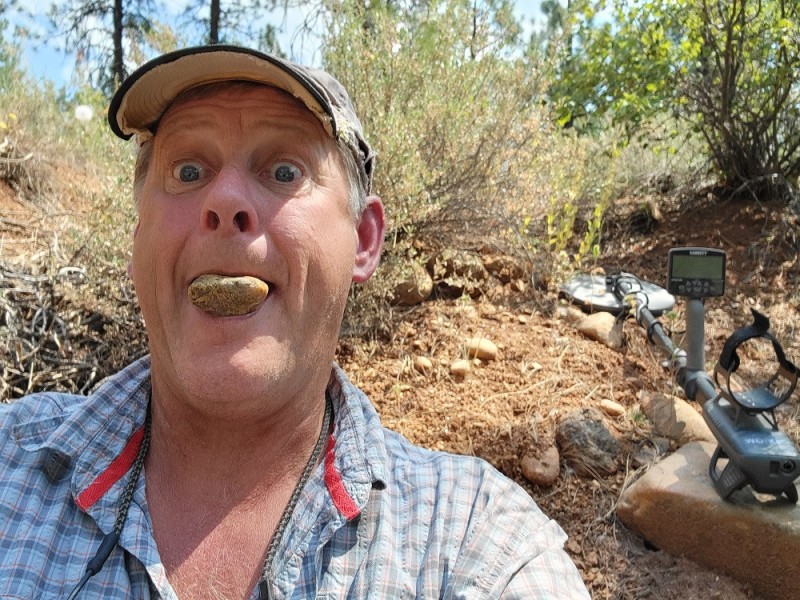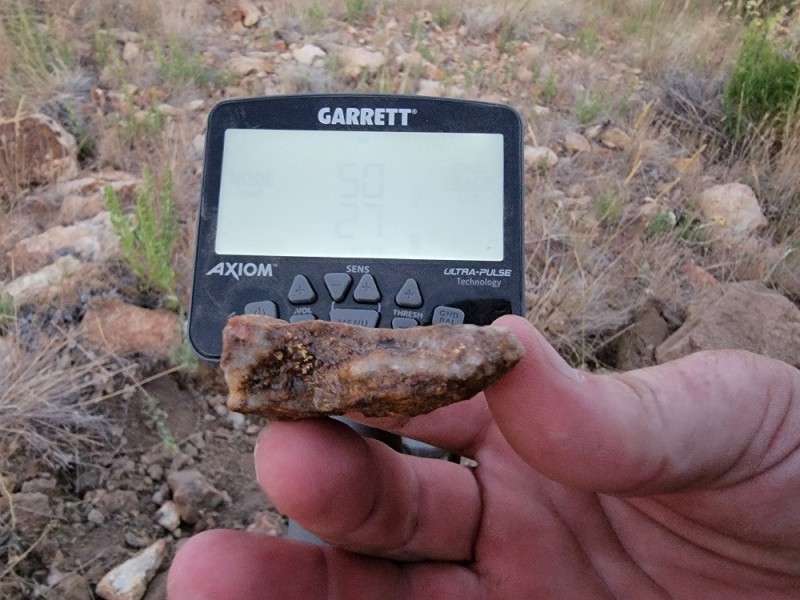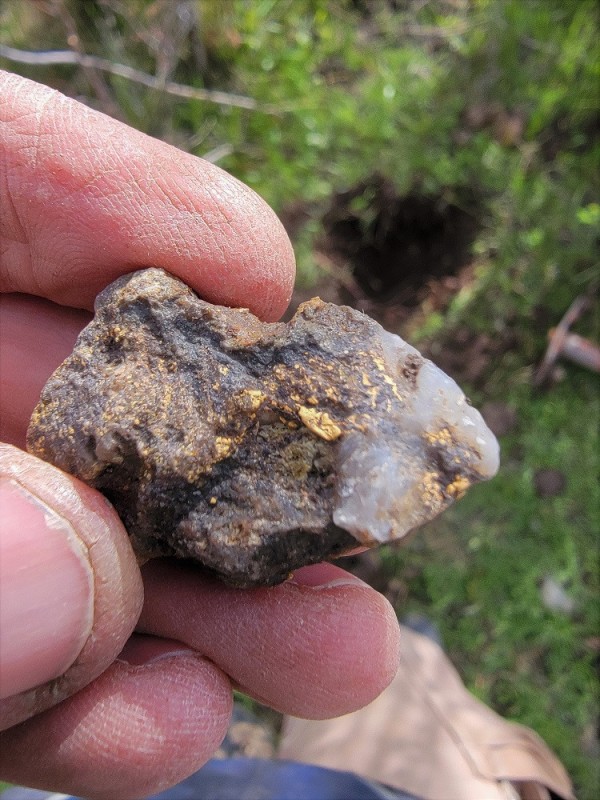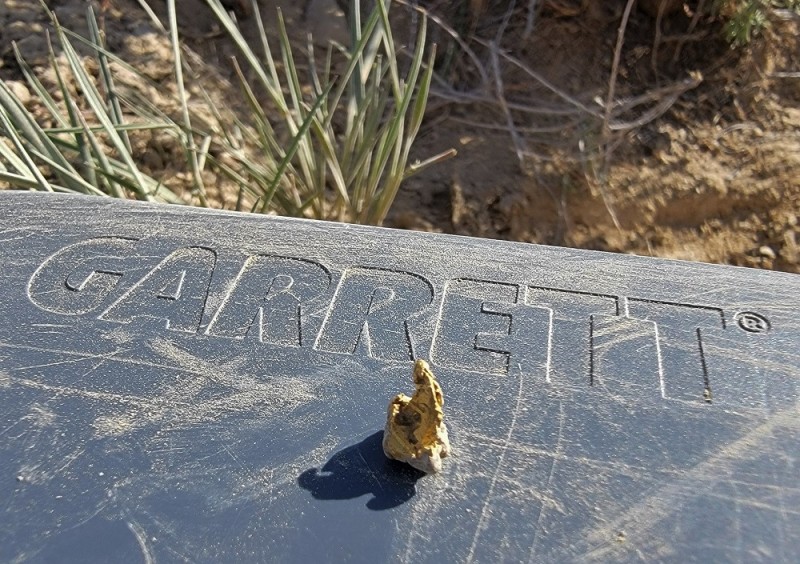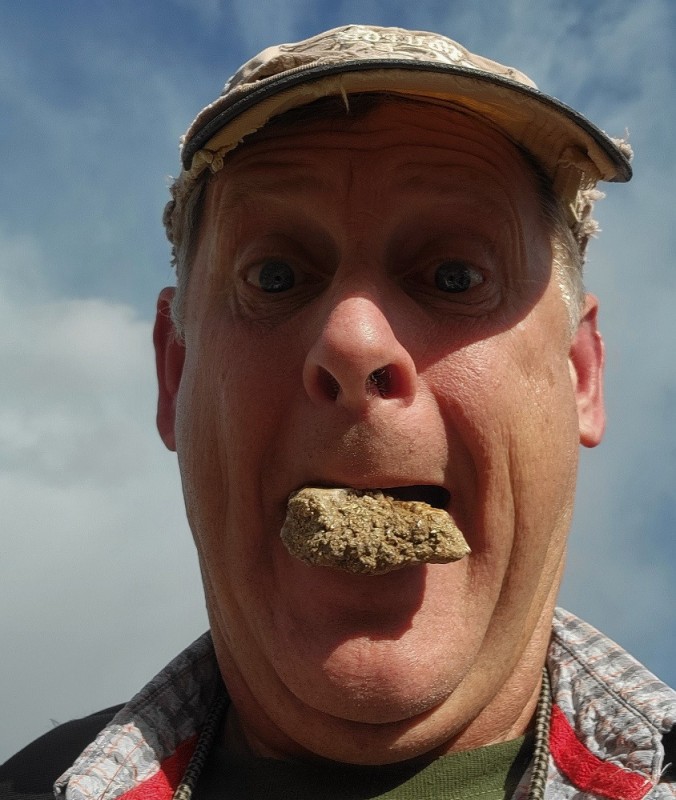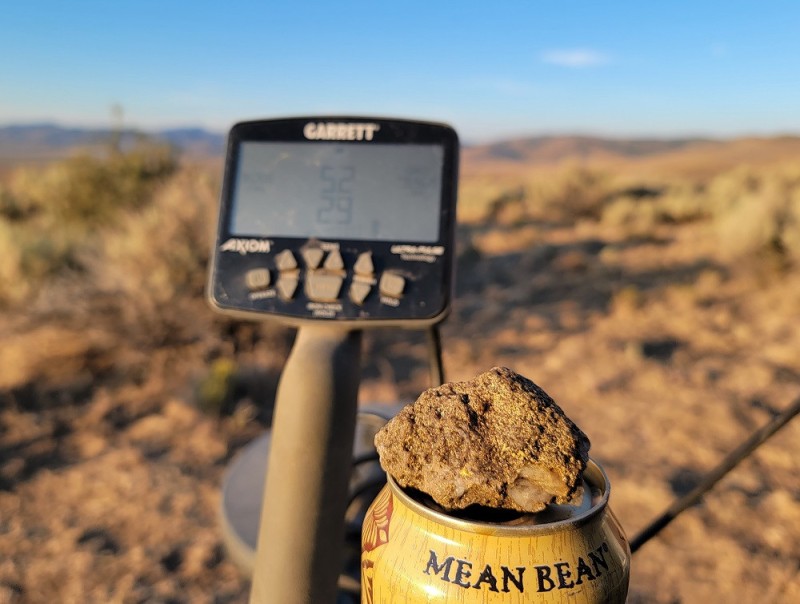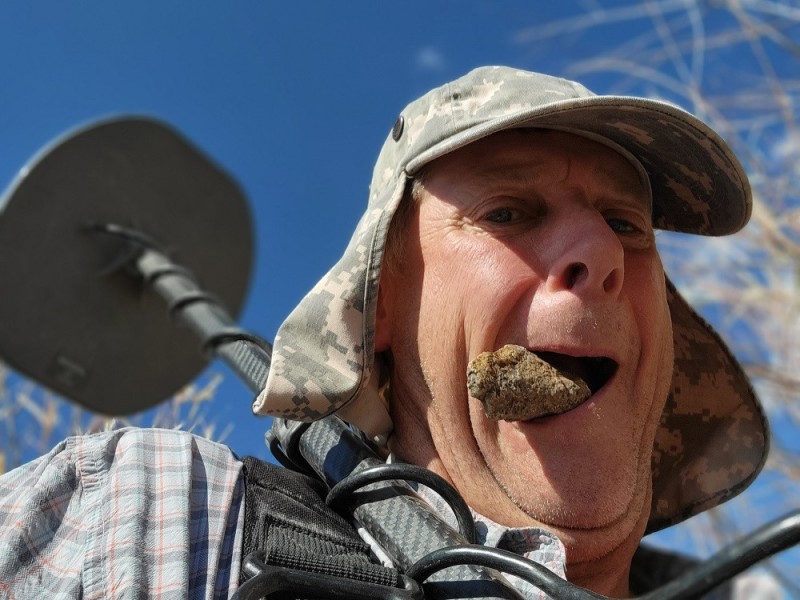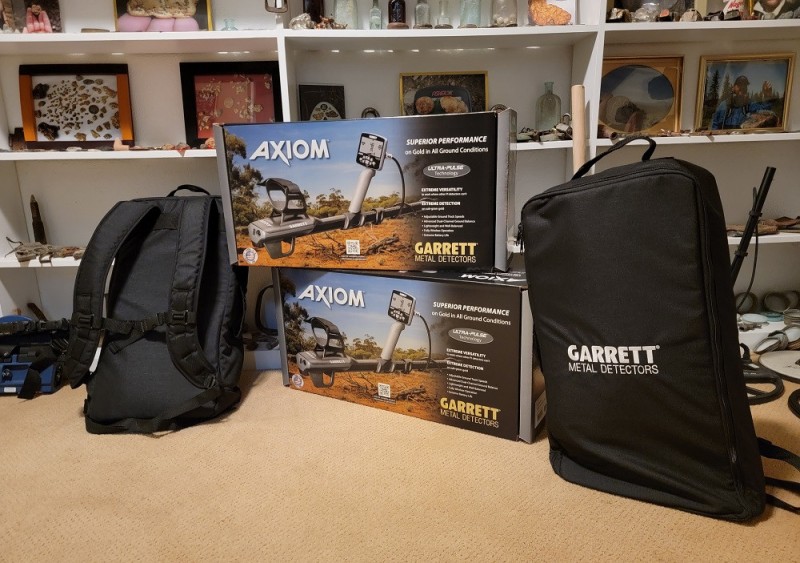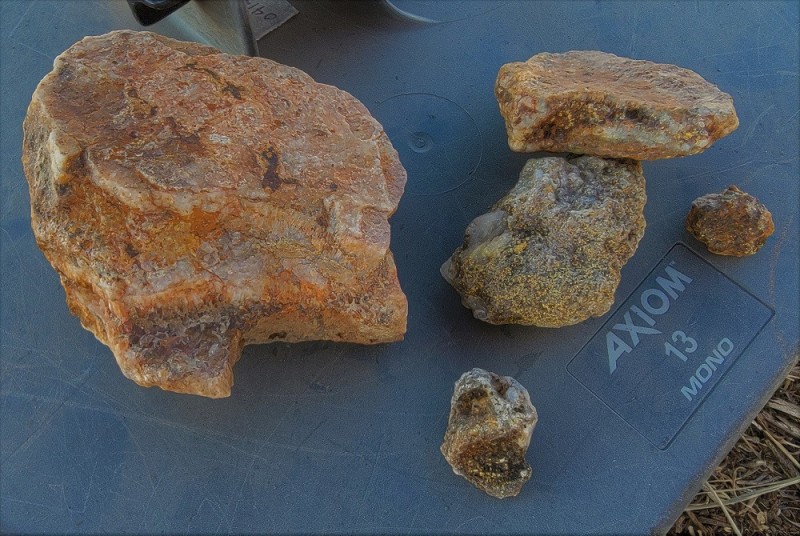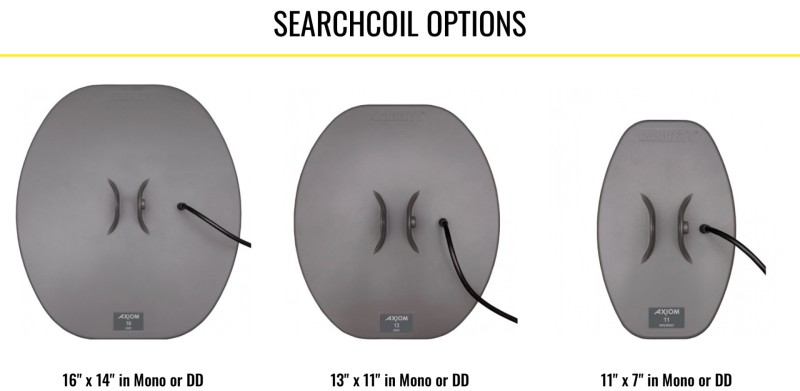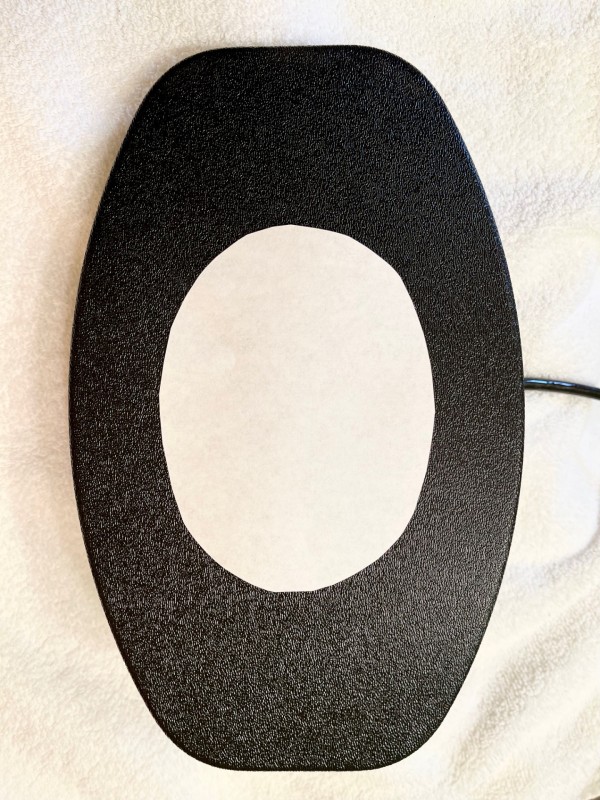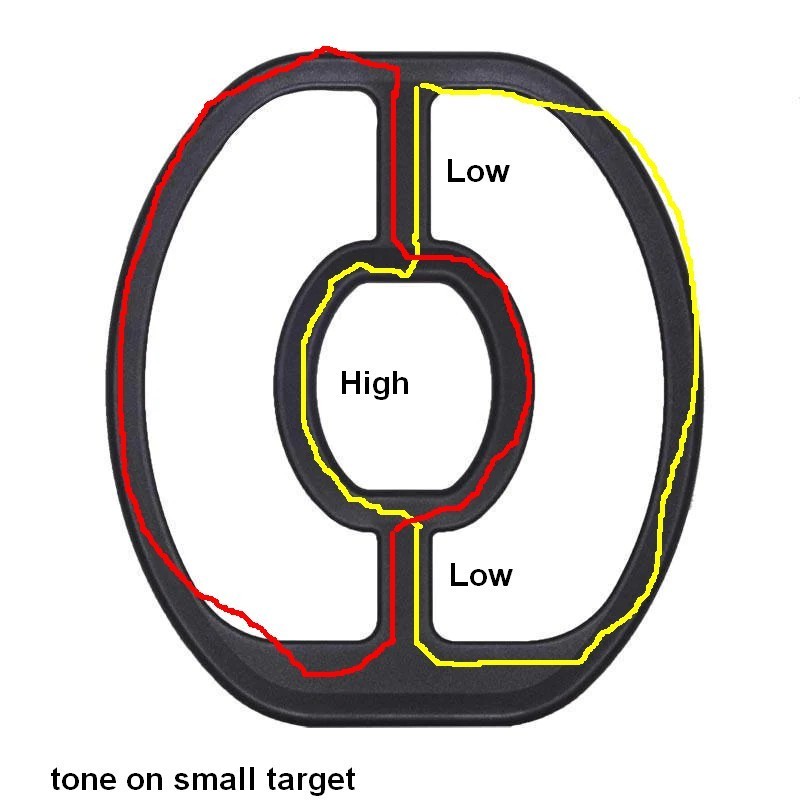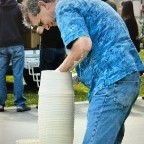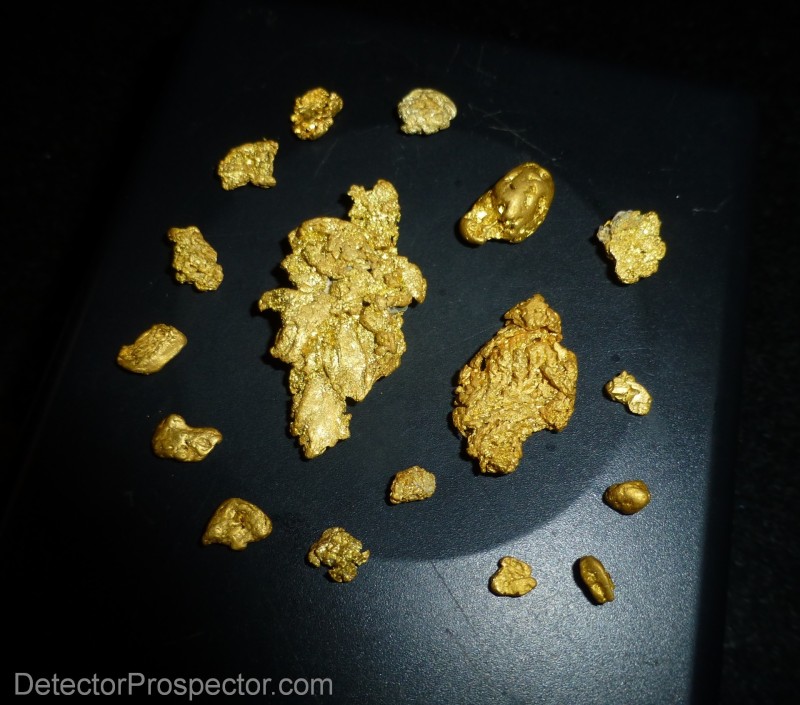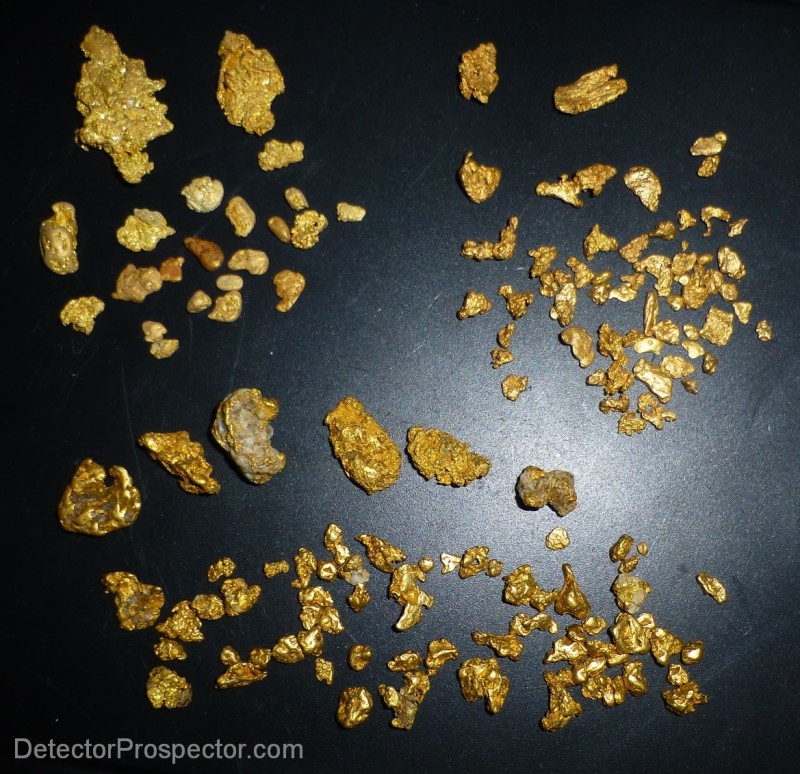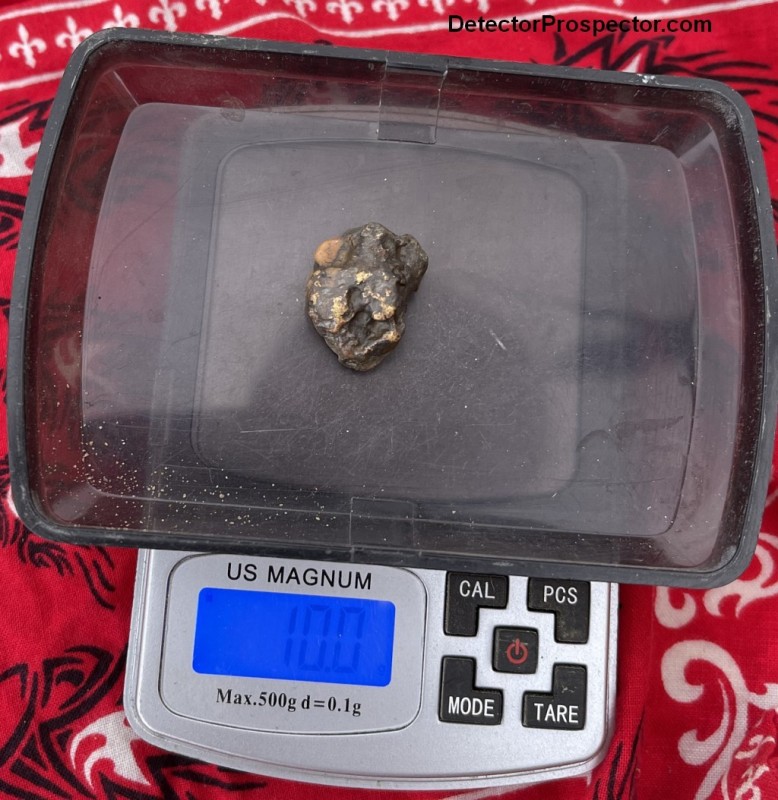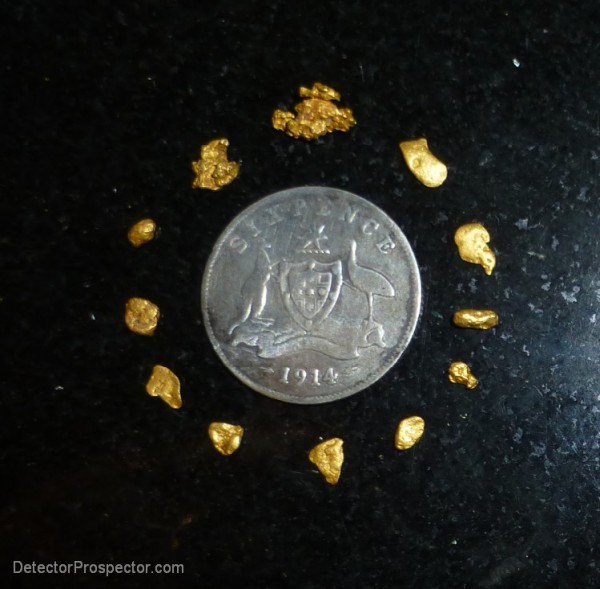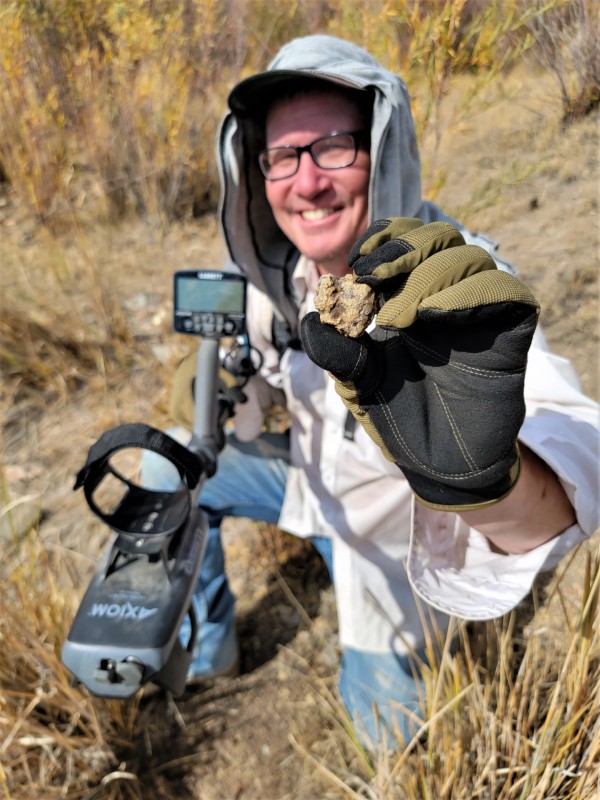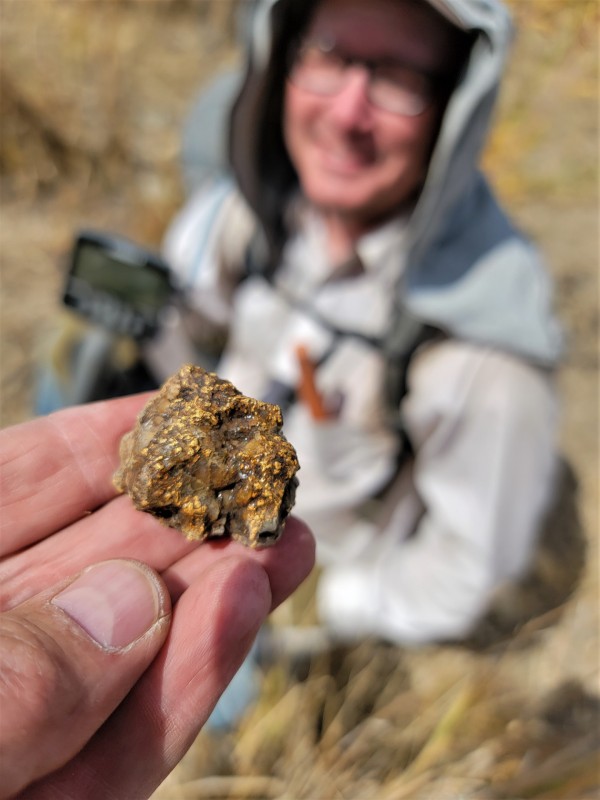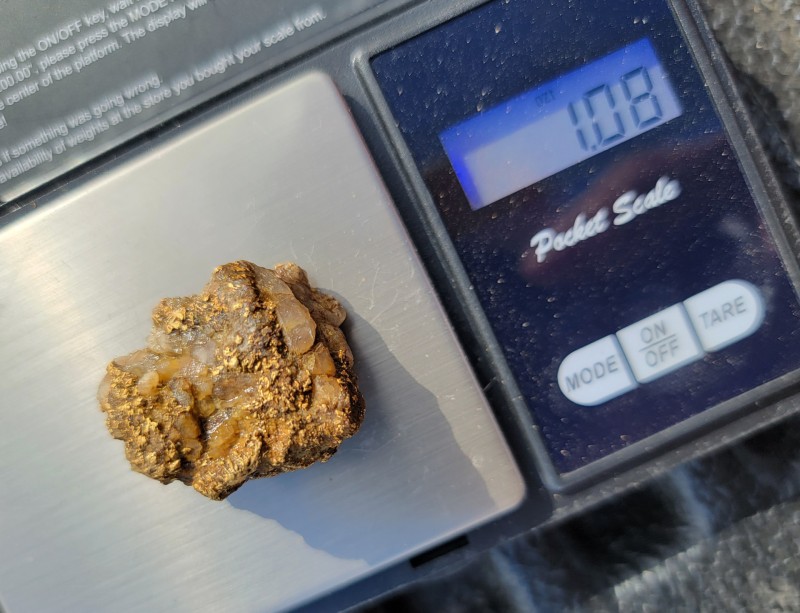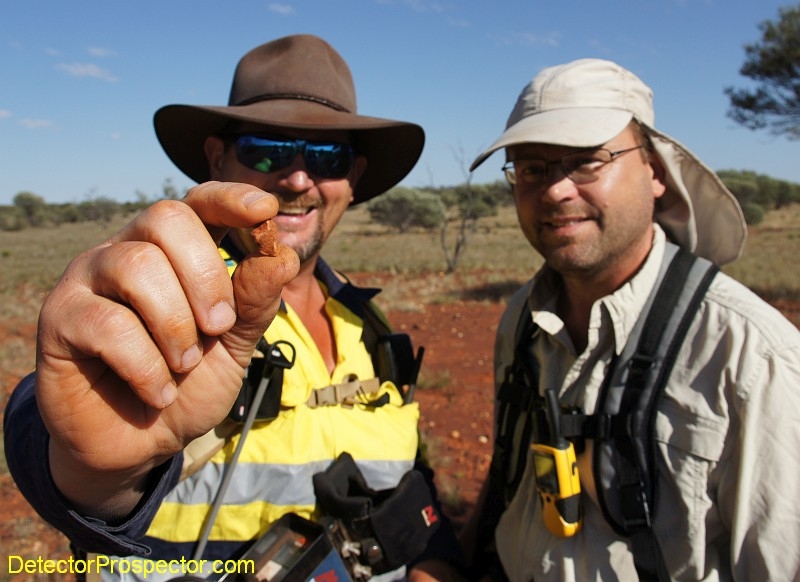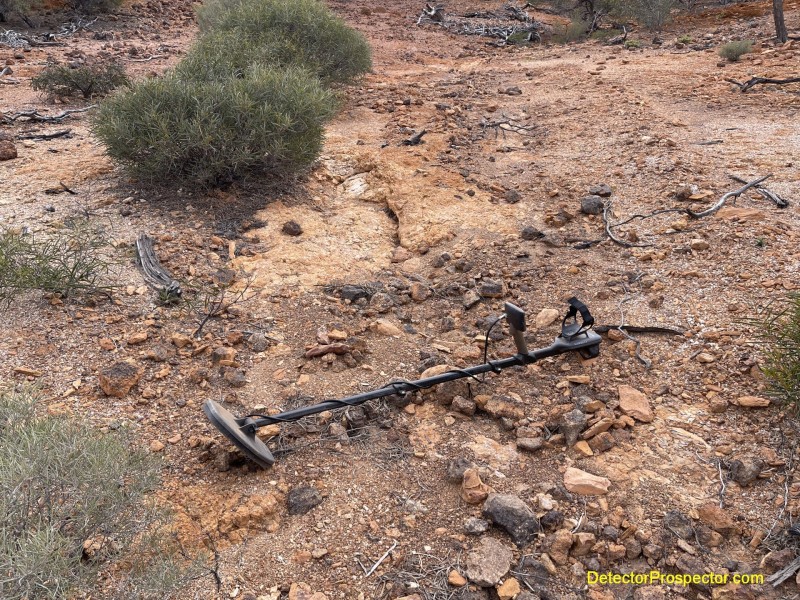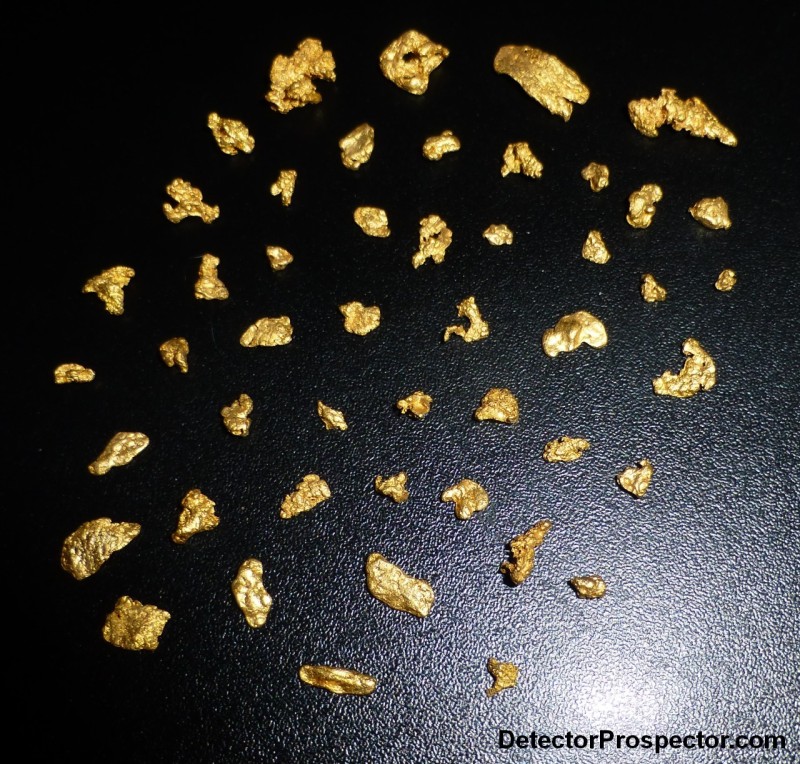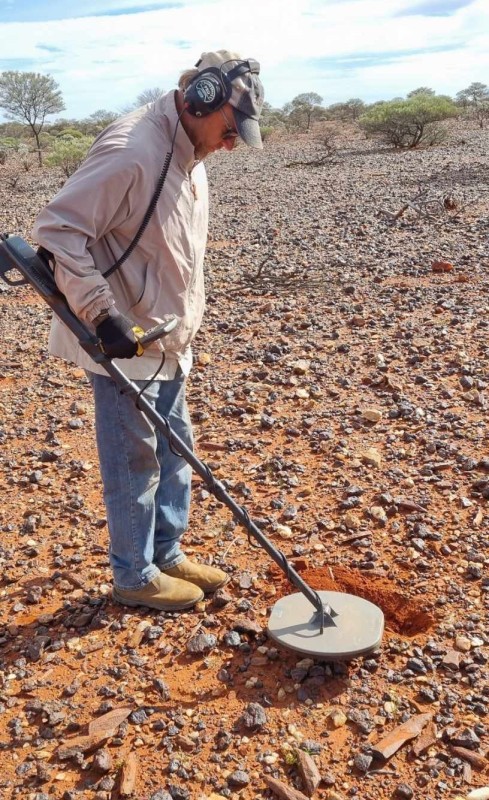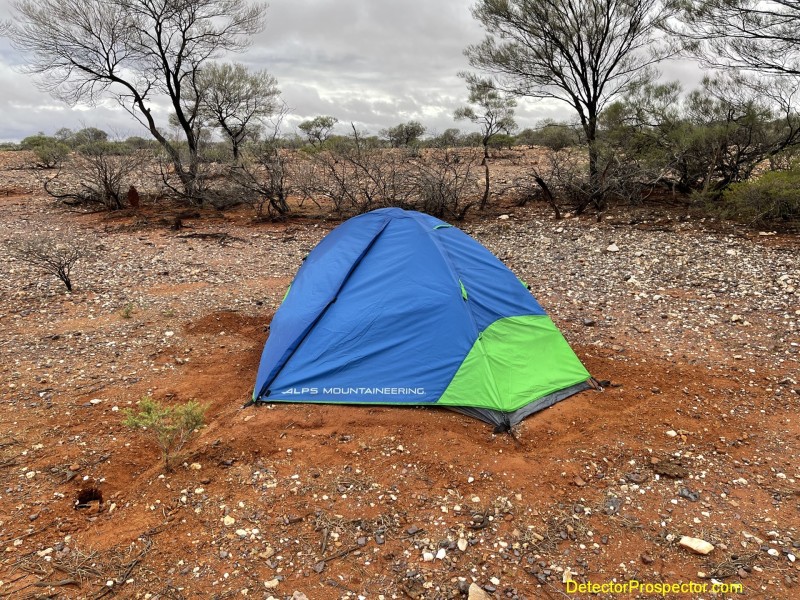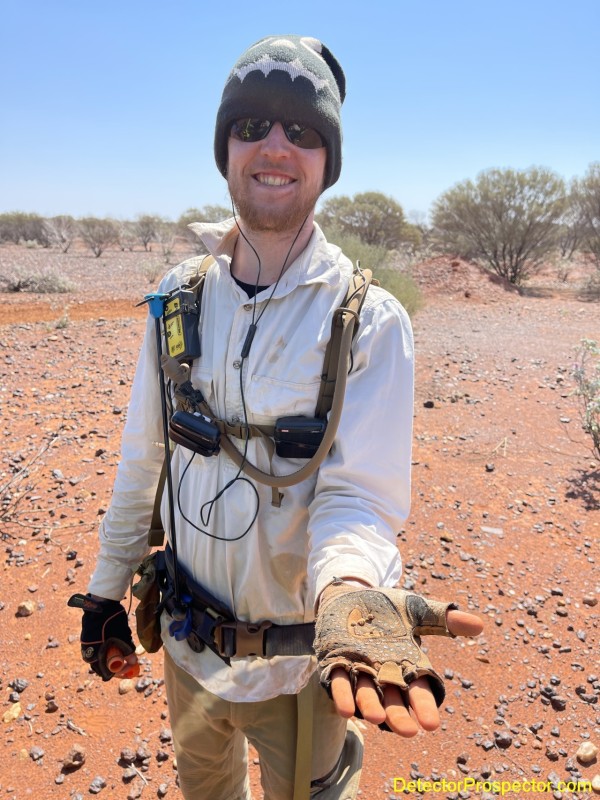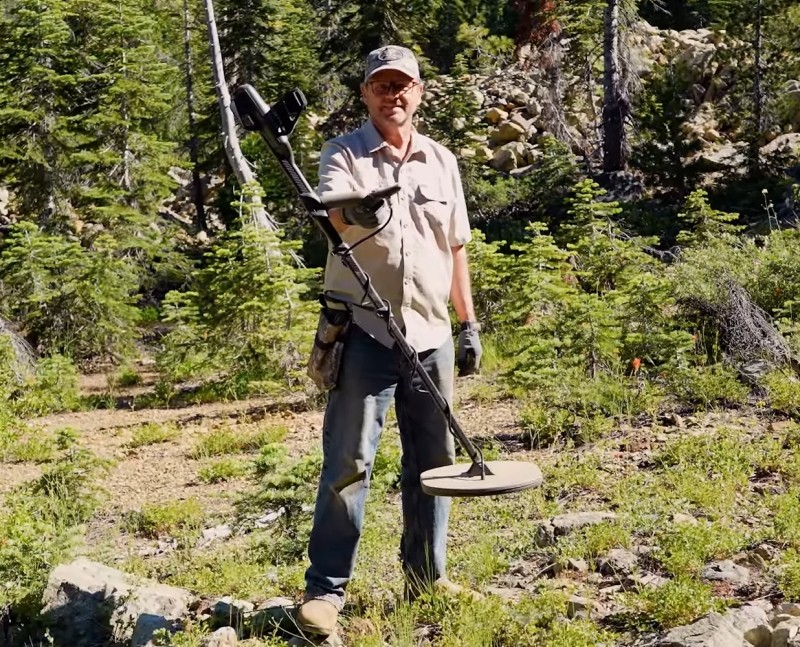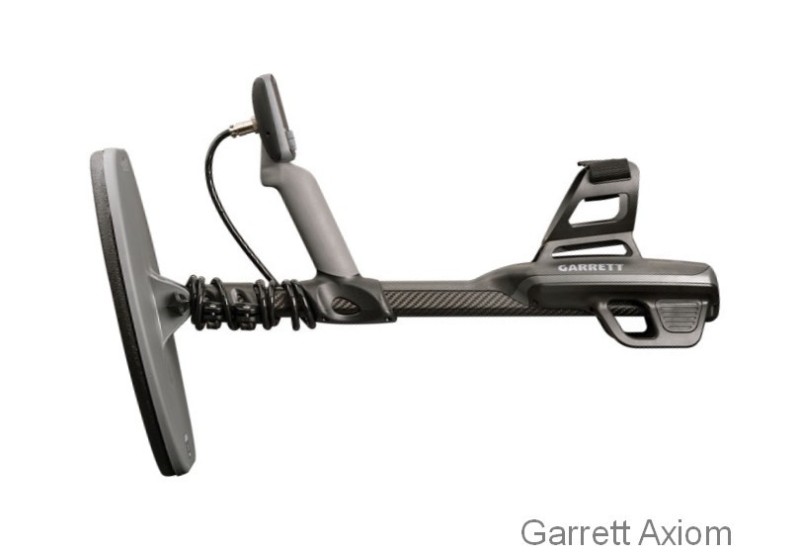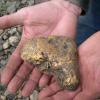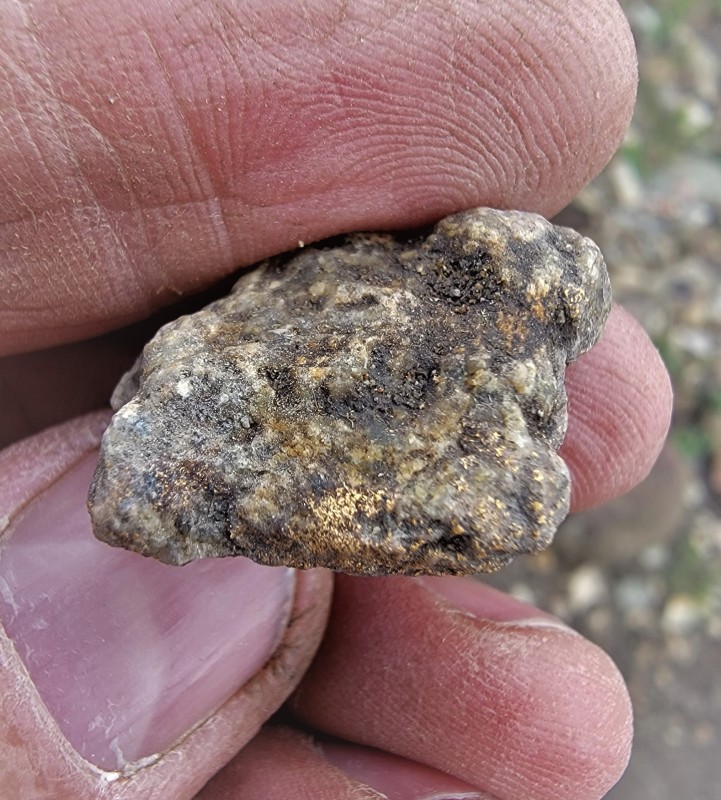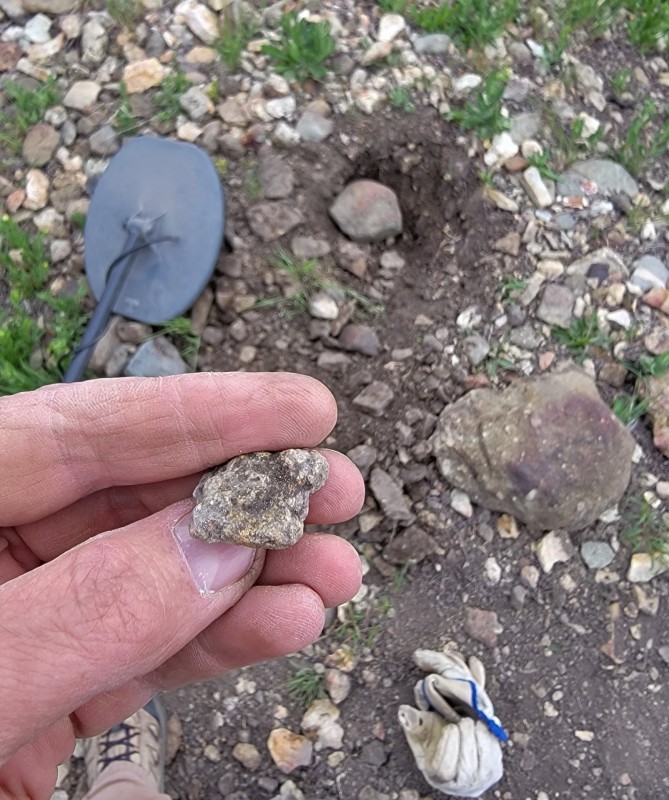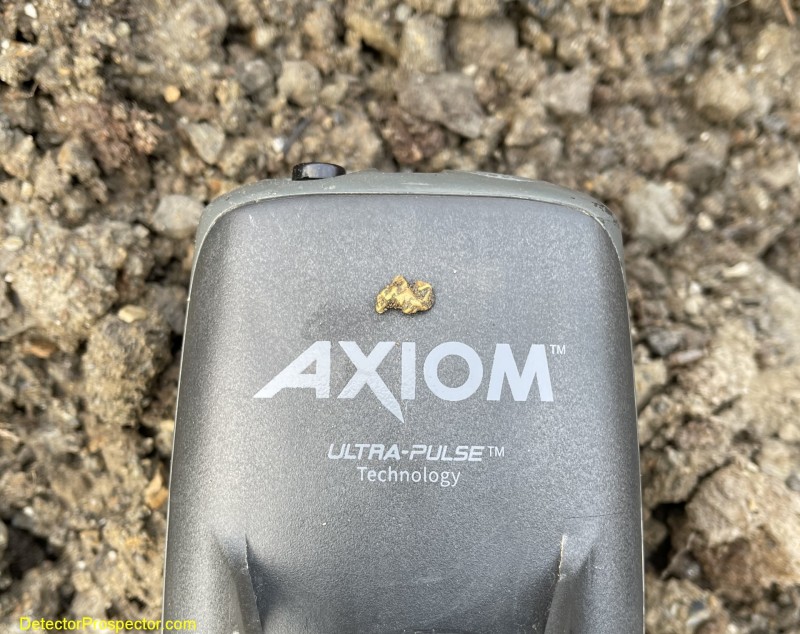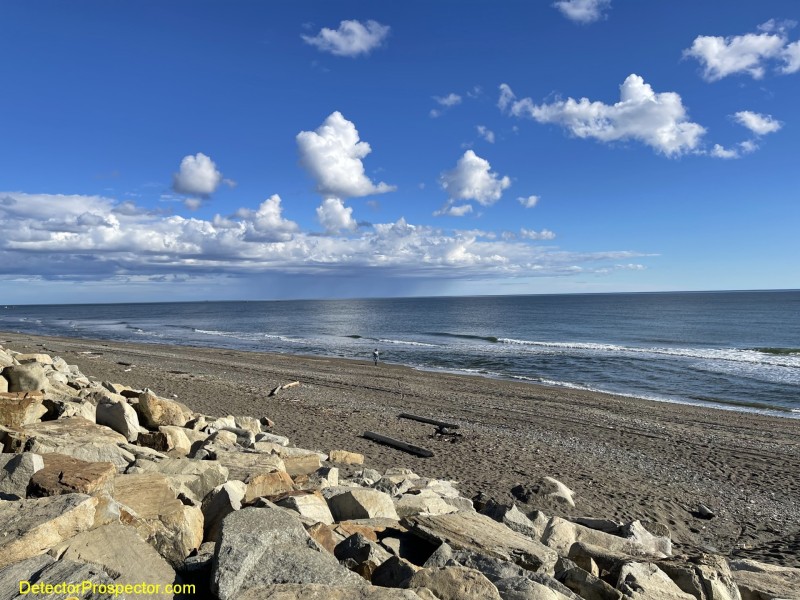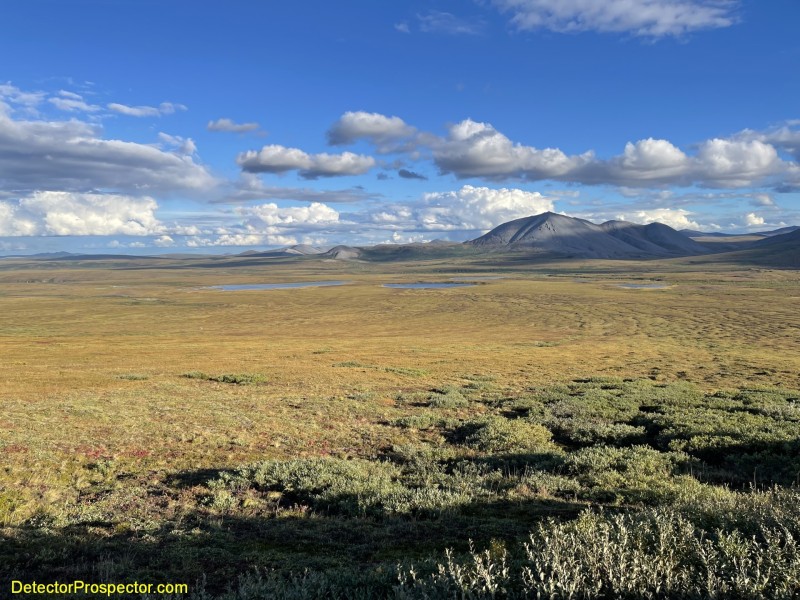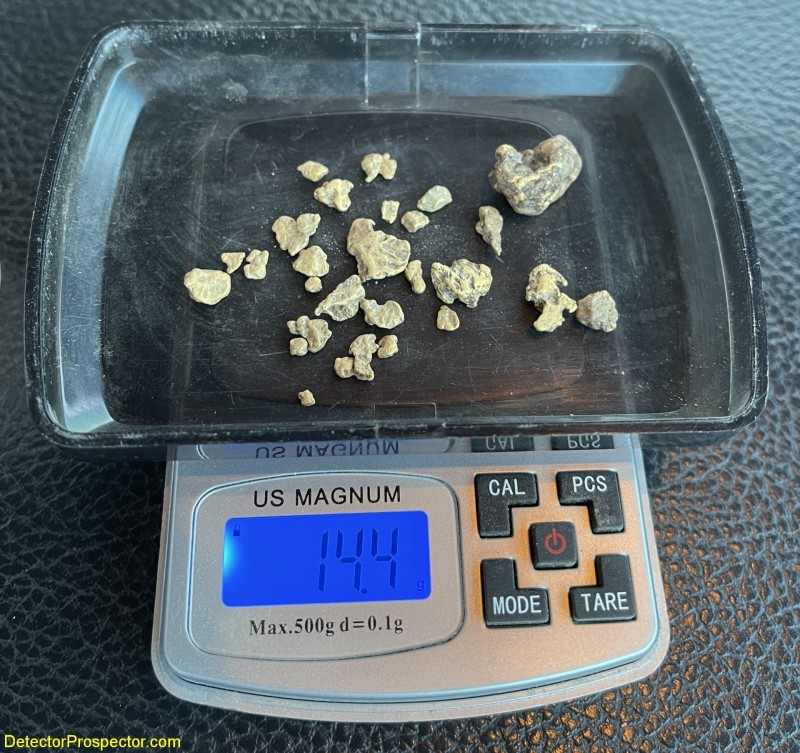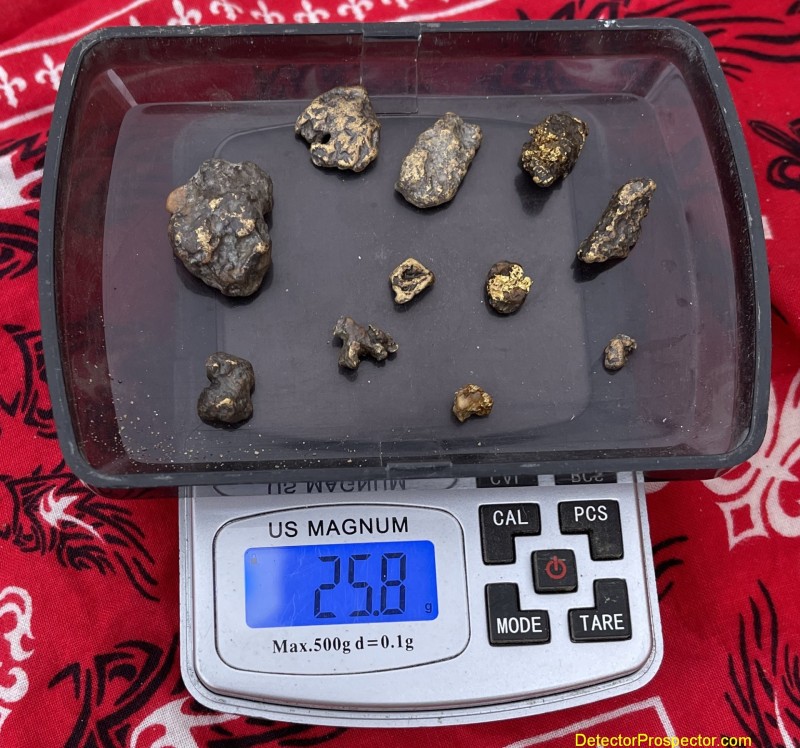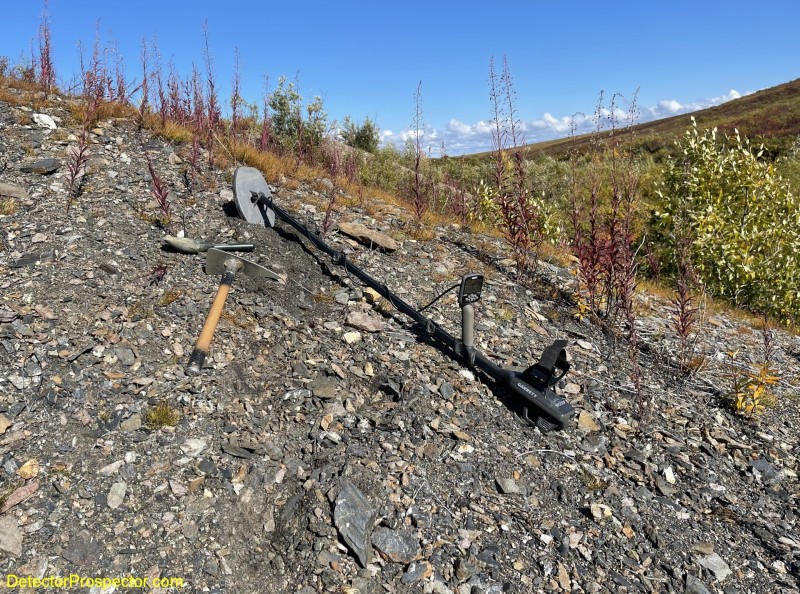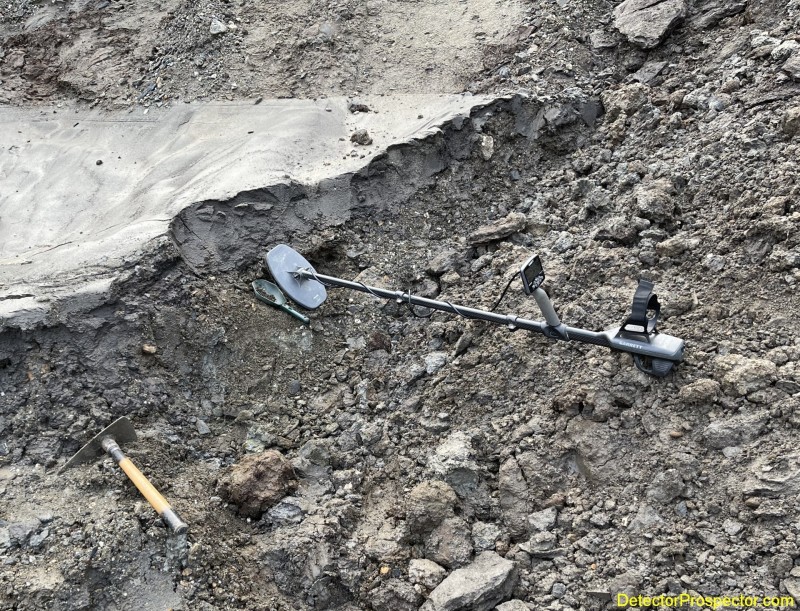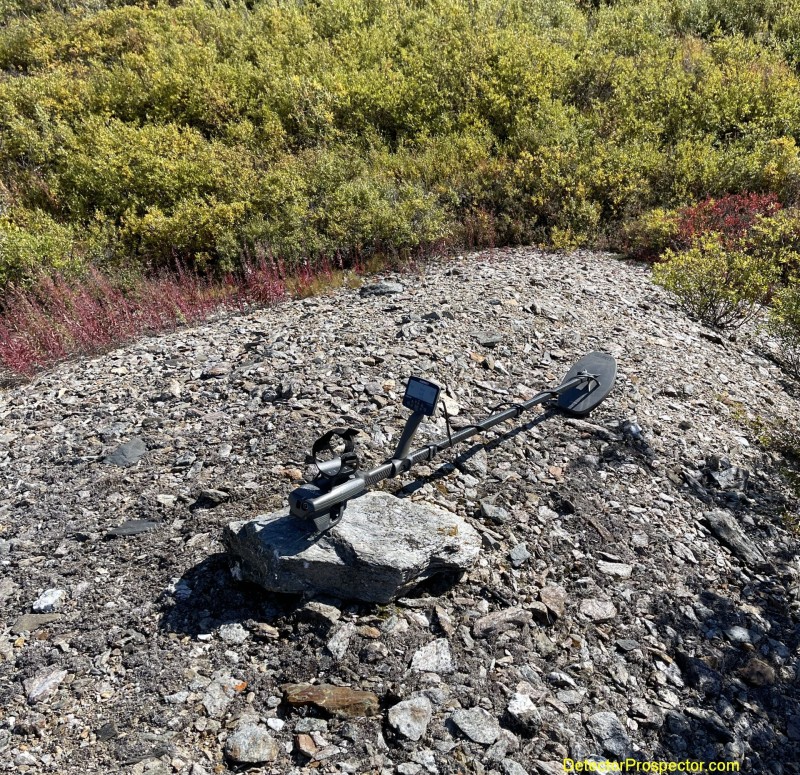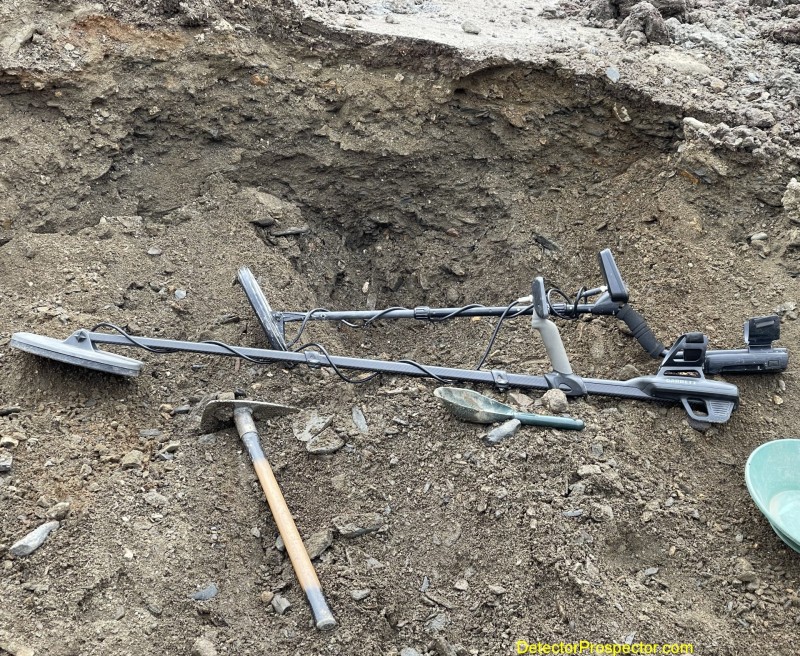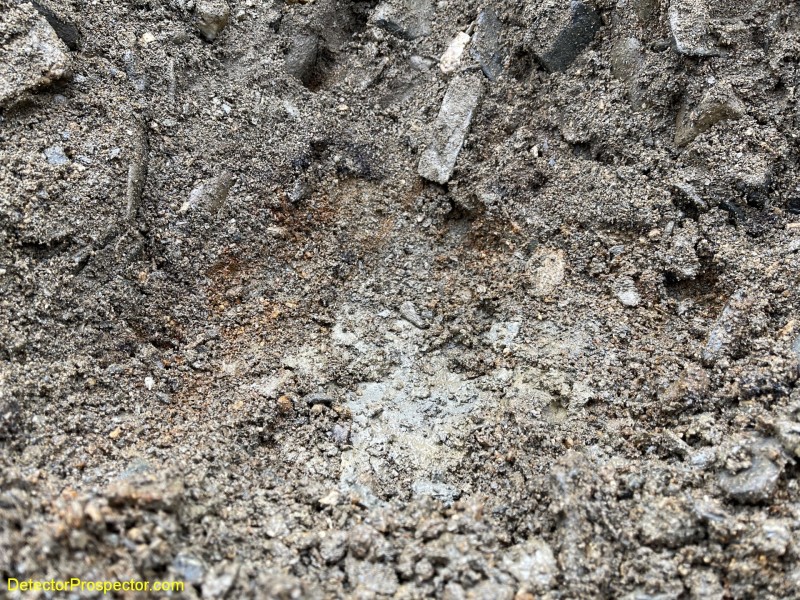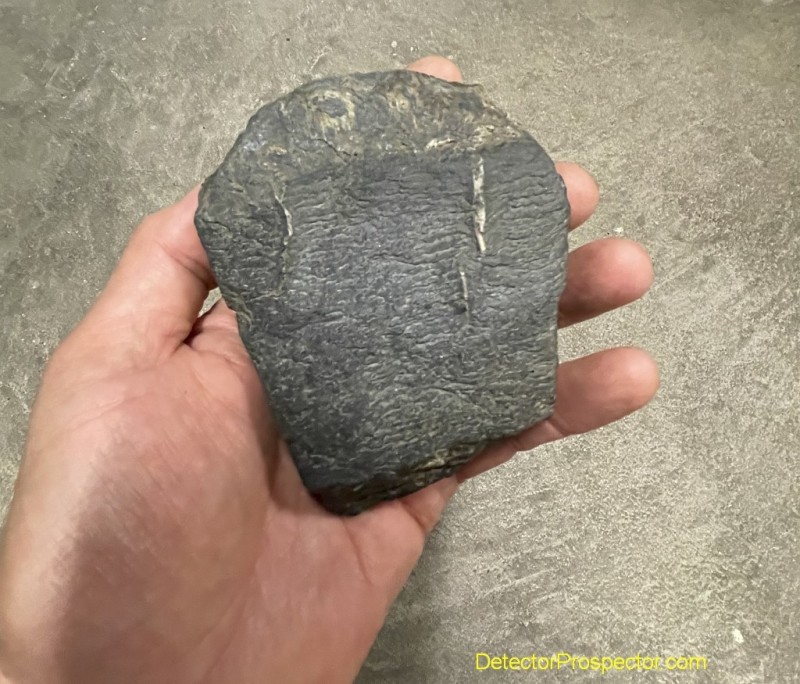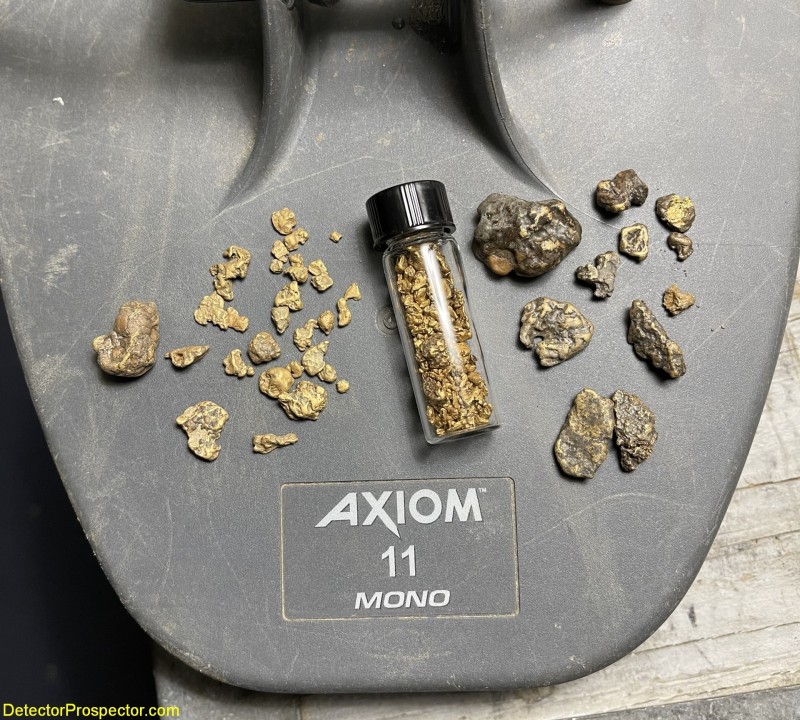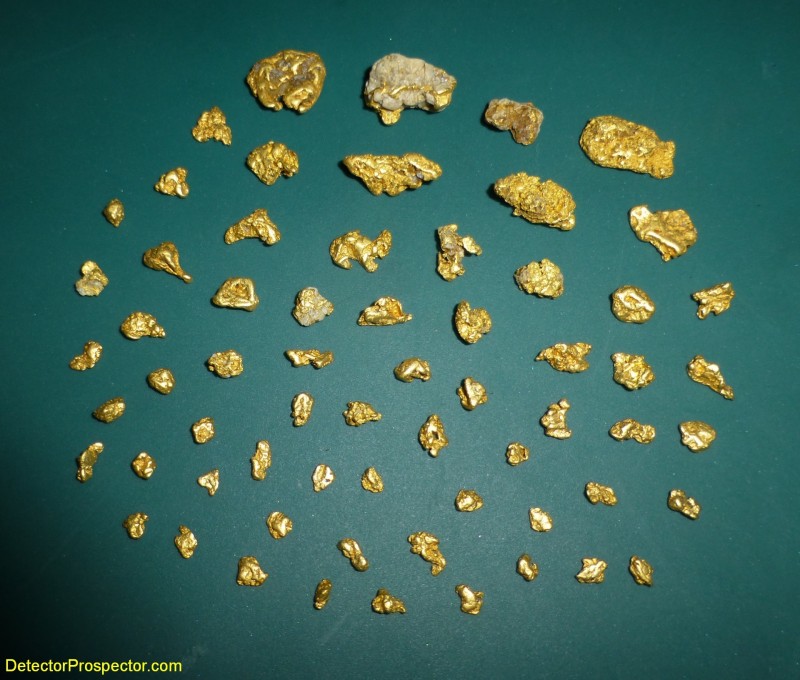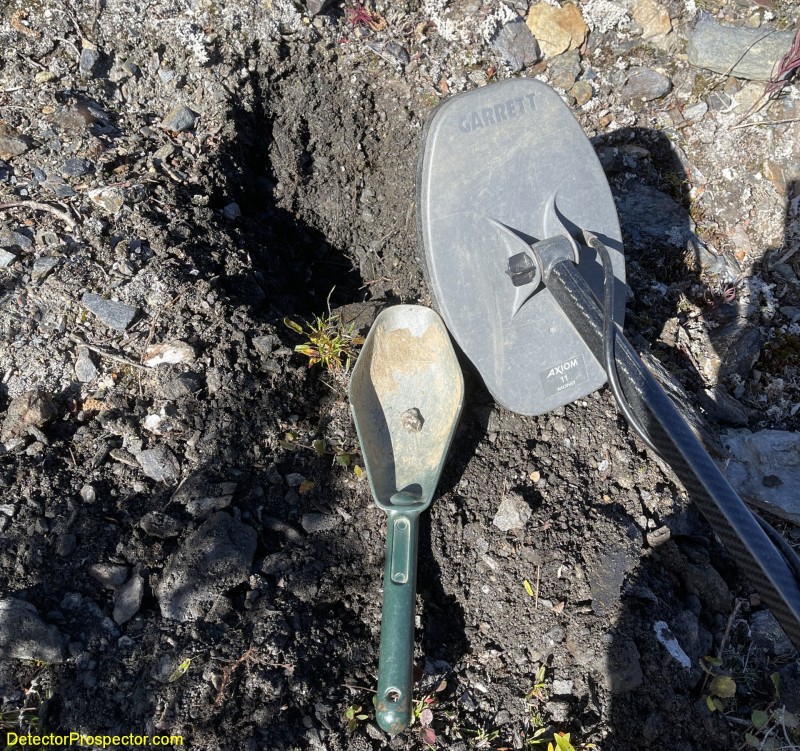Search the Community
Showing results for tags 'garrett axiom'.
-
See this video starting at the 1:40 mark. Hold the ground balance down for a full ten seconds. That is done to make sure nobody engages the window mode by accident. Keep in mind that normally when you push the ground balance button, the machine resets each time to whatever new conditions you are programming in. If you go ten seconds and open up the GB window, the machine is now in an accumulative mode. This can be useful for more than just hot rocks. Like those hot patches in burn areas, or clay patches, whatever. It broadens the ground balance system to work on multiple items. It is wise to use it with care and only when needed, but can also work miracles if properly used. The video shows a simple L type balance where you pump over the ground then wave over the hot rock. In reality I just play with the ground and the hot rock or hot patch until both mellow out. It may take waving or pumping or both. You can choose how aggressive you want to be by how you do it. Anytime you think you have dialed in too much, just reset the system by releasing the button, and then pressing again, to engage the regular simple ground balance. Very important to know! If you have a perfect window set into the machine, pressing the ground balance button again after that will clear the window, and start you over with regular ground balance. It's quick and easy, but every once in a while leads to an "oops" wish I had not pressed that, and you have to start over. Once people learn the ground balance system it will prove to be a real weapon for areas where other detectors drive you out due to too many hot rocks and hot spots in the ground. Now here is some really crazy stuff to experiment with. I only did this once, but now it is out there for people to explore and share. The ground balance window works on almost anything. I tried it by ground balancing on a nail, it knocked it out completely, and it still picked up coins!! Now, I have no idea where the limits are on this yet, and what gets eliminated when you do this, but the fact is you can use the ground balance window to tune out most anything, and still find other stuff. This may blow the relic market for the detector wide open. Or not. Just depends at what cost in lost targets comes with this method. But right off hand it looked to me like I could tune out some common ferrous targets and still have at least some response left on many coins, so you can bet I'll be playing more with this in the future. You can use the tones on the Axiom to separate small/low conductive (hi-lo tone) from large/high conductive (lo-hi tone). You have the iron check grunt for shallow ferrous. And now you have a fully capable ability to block out single target response areas with the ground balance, just like with the TDI, but in a dual ground balance machine. This should help alleviate the severe "hole" that developed when you used the ground balance as a disc control on the TDI. With the TDI out of production, we now have an even more powerful alternative available with a similar capability via the Axiom. Lots to look forward to and experiment with in this detector for sure.
-
I hit the hills with the Axiom again early this morning. After a 1 hour hike I arrived several ridges higher above my main patch from last trip. There are faint old-timer workings here and the plan was to make the spot "pay" up. Well, no luck again, skunked for the 5th time. But, I had my aces in the hole, a mini patch and medium patch on the way back to rework to hopefully end the day with some gold. Things turned out ok and I did manage 3 nuggets, the first 2 with the 11x7 mono and last with the 13x11DD. The first was a .33g I missed 10ft. from where my ML SDC 2300 got a 1.62g nugget at the mini patch and later a .14g nugget 3in. down at the medium patch. I swapped in the 13x11DD and got the final nugget a .13g that came out after the first scrape with the pick. The takeaways are gold sources aren't necessarily higher up from patches, the Axiom is very sturdy and nugget #1 was found smashing short bushes where the SDC had been. And the 13x11DD hot spot in the center of the coil found the smallest nugget of the day. I definitely agree with Steve H.'s warning to not try to overdo the sensitivity on the Axiom. I did a factory reset today and repaired my headphones, but ended up using my Sunray Pro Golds. I had the same issues as my first trip with the connection. I kept sensitivity at factory 4 with headphones. Higher is a bit loud on the ears and you start to get ground noises if the ground is highly-mineralized. I ran a bit noiser than I usually do, but all in the name of science. Related to the sensitivity control, I noticed I had to "juggle" settings for threshold, sensitivity and volume to get things sounding smooth and not over-driven. My settings for speaker use and headphone use differ greatly. I used way lower settings for headphones so watch out for that. One nice surprise that I might be imagining is the overload response to targets is shorter than for other PI machines I've used. Nice to get the blaring over with quicker. Maybe the Axiom has a faster recovery speed doing that. Spot #1 today had a part of it burn in a wildfire. I run across spots of carbon from burnt stumps or roots there and they've sounded off using my ML GP3000 and SDC. I did get some noise today too, so the Axiom responds to charcoal like the other PI. However, I ran all day in automatic ground tracking and it smoothed things out a lot so most burn spots weren't an issue. I tried a manual balance for a brief time and those charcoal spots got really noisy, so back to auto ground tracking for me. At times spots of ground get a bit noisy. A few pumps with the ground balance button pressed and back to quiet operation. Very quick and easy to do and works great. The Axiom likes certain hot rocks, but I get the same response to them on my ML GPX 6000 here. I get some occasional extremely heavy, dark magnetite of good size in the area. The larger ones deeper got me excited with faint signals and I dug several. It seems the golf-ball sized ones fooled me. At least those are easy to spot once out of the hole. I know you can tune out hot rocks with the Axiom, but since I only ran across half a dozen there was no need. I'll possibly add more as thoughts occur to me and try to answer any questions people have. I didn't do any empirical testing today, just beep and dig.
-
I hope this doesn't ruffle any feathers but my main concern is getting the Axiom in the hands of as many users outside the USA as possible. Now a few guesstimates* are included here, but my price reasoning for Australia is thus: Wholesale price: US$3,000* Exchange rate @ .65= AU$4615* GST Tax AU$ 460 Air freight (% of large consignment) AU$ 25 'Normal' wholesale markup (25%*) AU$1153 'Normal' retail markup (33%*) AU$1522 TOTAL AU$7775. Now, given that there will be % adjustments in the 2 markups and US wholesale price, we can now see where the AU$7300 RRP here in Oz comes from. Now I am not advising anyone to do this, BUT no doubt quite a few ppl will indeed do this... Get a 'Friend' to buy one in the USA @ US$3995 (Exchange AU$6150) then pay the GST tax and airfreight which will be around AU$6950 total. So, even though you're saving a few hundred $$, you have the issue of no local warranty support and all issues have to be dealt with by posting the unit back to the USA. IMHO, not worth the saving, especially thinking long term. If the exchange rate bounces back above US$-AU$ of .75, then we might have to rethink. I think the whole exchange rate issue is the main detraction. Sad but this detector deserves more exposure around the world. I sincerely hope it achieves this, despite the pricing.
-
There has been a Xmas promotion in OZ, an EQ600 thrown in with a new Z and 6K, in the US a Monster but what is the above dramatic vid about? The Manticore and the ??????? . Maybe Garrett your finally taking the gold, good stuff......
-
Happy Turkey day everyone! Yes, I'm a prospecting scoundrel being out here at this very moment nugget shooting on this family-oriented holiday. But, I got the go ahead from the wife and kids to do a late dinner tonight. I've done a few quick tests of my new Axiom in a familiar patch area that's like an old friend on life support. Sad to see a patch dry up, but I know there is still gold on the fringes. I tried out the 13x11DD on the hottest patch of dirt I know of and it drives all of my PIs nuts, especially when wet like right now. I got the machine calmed in Normal mode/timing and sensitivity at 2-3. Nice to have adjustability like that. Next I headed up the ridge to "milder" dirt, its "only" highly-mineralized instead of red hot, haha. We've cleaned it pretty well, just a few pieces of small rust and an almond-sized hot rock with the 11x7 mono equipped now. I did snag the smaller nugget on a steep, very rocky spot 2-3in. down. It was likely missed by larger coils that didn't fit. I just pulled this second nugget at a spot where an old timer's ditch hits the creek. It's loaded with nails and is a spot we've "saved" until last. Down 3in. on bedrock, I was sure it would be a nail. It was not, and something to be thankful on this day! My tough ground is challenging the Axiom pretty hard. I'm in Fine mode, but on sensitivity 2. Higher sensitivity levels are too much, as Steve warns in his sensitivity control guidelines thread. HEED his warnings! The only hitch has been the wireless headphones. They frequently "pop" and wireless is lost for an instant. Seems to happen when my head nears the coil to dig or run the scoop over it. I've had a few times its totally disconnected. Standing up reconnects it. Multiple repairing and even a factory reset haven't solved it. I'm running the speaker now and I'm glad this unit has one. It's plenty loud and clear.
-
Let me start off by saying, I normally do not mention other brands and or models of detectors when I'm giving kudos to those who have earned it. But at the same time, I also realized I've been giving the same kudos for years to those other brands and detector models my staff/I prefer and or use. So I'll stuff the rock in my mouth now and get it out of the way. 1 year this month is how long it's been and boy what a blast and fun my team/I has had. Funny, how they are just now (a yr later) getting into customers hands. Better to wait a little and get it right than piss off the world.. 1st off a big thanks to Garrett Electronics and their distribution center for getting the Axiom out to my customers in time as some of them are already in their hands and I’ve been told of some Thanksgiving detecting going on. As many of you follow on DP, my staff/I were selected to work behind the scene and help make this detector even better. Being a US Military Veteran, I was also very adamant about Garrett offering a 15% military discount, which they have never offered in all the yrs I've been selling their products. On a side note, I was one of the most vocal dealers to talk Minelab into the same thing yrs back. I heard a few dealers are not offering it (it is voluntary) but here at Gerry's Detectors, I most certainly will do so. One of the things about the new man in charge at Garrett, he is a thinker, but most importantly, he listens. No, I didn't get everything my way, but I feel what changes have been made are all better for, end users of the Axiom, dealers who sell it and even Garrett themselves. Back/forth open discussion is critical for new releases, the longevity of our hobby and the manufactures who build them. Hopefully other manufactures do the same. My Field Staff and I have spent hundreds of hrs on the new PI technology using/testing/comparing and making judgment of this new detector while finding gold in 3 different states. We even shared it for a bit at the last Rye Patch NV Field Training class and watched Lunk pull a small nugget some of the other big machines missed. No, it doesn't have the same raw depth/power of $8500 detectors but at the cost of only $4000 ($3400 with VET discount), you sure are getting 85% to 95% of it, depending on soil conditions and kind of gold. Why do I say kind of gold? Because some types of Au rocks and nuggets, the Axiom has greater depth/sensitivity. I've been swinging a variety of detectors for 45+ yrs with the last 25+ in the pursuit of the heavy metal. I'll admit the majority of top performing detectors for my Au tasks were not from the Garrett brand. In my opinion, they and the other manufactures just could not put a complete machine design to my liking for the styles of my hunts. I've owned Infinium, AT Gold and even the ATX. They are nice machines with a couple good features and their price points are what you would expect. But the bottom line, I would always going back to the well-known brand for most situations….until now. Thank you Garrett Electronics (and all the people involved with the making of this fine detector) for providing a PI detector option at a reasonable price that actually performs extremely well for a variety of conditions and on many different styles and kinds of gold. My Field Staff and I (each one of us) are more than pleased and actually quite blown away that you could come out of nowhere and produce a detector of such caliber. My guys and I are used to running the best of the best and we’re willing to pay whatever the price to do such. So when I told them about said machine and they selecting my team to test it, they (my guys) just played along and said sure. It was as if them telling me. We’ve been down this road before Gerry and we’re pretty sure of the results. Well to be honest, I couldn’t blame them for be so…so.. ok we’ll do it…but as soon as it’s over, we’re back to what gets us the gold and the machines we prefer. Not so fast my friends…. Things didn’t play out the way we expected. My guys are totally on board and eager and wanting to get back out there with this Axiom. They’ve pounded the ground, sweated the heats, broken the frost and still happily swinging the Axioms. Why you say. Cause the results are golden and they pokes have been overflowing this year. Folks, I say this as FACT and no bullshit here. This last year 3 of us found more gold than we did the previous year. We attribute the success to the Axiom and the way it runs, the features it has and the overall performance for the areas we detected. Garrett has made a detector that will provide so many people the ability to enjoy it’s benefits of a PI. PI’s of past are just that, the past. Prime example, why so many people in the US go from a GPZ-7000 to a GPX-6000, when the 7000 is still the deepest big gold detector out there? I’m guessing here, but a big % of my customers was the weight and ergonomics. Those who waited to see and hear the results soon found out so much of the big gold had already played out in the US. But still the GPX-6000 was finding small gold and specimens better than the 7. So for many, the switch was a no brainer. Now we get another option from another player and this one has features the other 2 mentioned do not. This one has better coil selection the other 2 do not. This one is priced much better and more affordable for more people. This one, the Axiom.. is a great detector to be thankful for. I'm not saying it beats the others in every way, never have, never will. But the overall capabilities and fun factor...let it shine let it shine. Again Garrett, your complete family and also Steve H. (yes you had more to do than many realize), I thank you all for giving us the gold detecting, beach hunting, and CW Relic era detectorists an amazing option to use in the field and have fun doing what we enjoy. You really built a detector that has impressed me and most of all my Field Staff, way way way more than what we initially expected. Cools digs.. We are lucky to live in a country that allows us to enjoy a variety of hobbies, allows us to speak our mind and allows us to have a little fun and laughter. If you are not smiling, choking on a chunk of Au or getting a laugh with friends while out enjoying the Hunt, then I ask you to please grab your detector and go make some memories. Finding the gold is just part of the fun. Thank You All and Happy Thanksgiving. (some new pics many of you have not seen). Gerry at Gerry's Detectors in Boise, Idaho.
-
When people familiar with metal detector coils hear certain terms, they think certain things. Here are the three classic coil designs, illustrated in many articles in books, magazines, and the internet. Mono and DD coils are common, concentric much rarer with modern VLF and PI detectors. A classic mono transmits and receives alternatively with a single coil winding, and so is only used on pulse induction detectors. DD and concentric separate the transmit and receive into two separate windings, and so can be used in both PI and VLF designs. Metal detector coil types illustrated - concentric vs DD vs mono Garrett has some unique coil designs, but refers to them by the old terms. This leads to some confusion and incorrect assumptions about how the coils will perform. In a classic sense, a mono combines the transmit and receive into a single coil. Since depth is connected to how large the receive coil is, a mono often had better depth on larger targets than a similar size DD coil. The DD has separate smaller transmit and receive coils enclosed in a housing the same size as the equivalent mono. The smaller receive area often puts the DD at a disadvantage compared to a mono for depth on larger nuggets. A mono tends to be hottest on small gold very near the winding, around the edges of the coil. A nugget next to the winding gets the most benefit from both the transmit and receive phase, since the one winding is doing both. This leads to an odd effect with the smallest gold, where a mono coil has a soft, or non-existent signal in the middle of the coil. A clue to small surface nuggets is when a mono coil gives a double blip, one on each edge of the coil as it passes over the nugget. A classic DD coil tends to have a milder response to small nuggets, since over a lot of the coil surface a small nugget is far away from either the transmit winding, or the receive winding. As a result, with small nuggets you get the best response in a narrow band down the middle of the coil, where the transmit and receive coils overlap. In the last decade mono coils have been more popular than DD coils on pulse induction detectors for that edge on larger gold depth, and users have learned to hunt with the edges when chasing the smallest gold. But DD coils have some inherent advantages in ground cancellation and EMI handling, and Garrett decided to try something different when they made DD coils for the ATX. The main complaint was how narrow the response was on a standard DD coil, so what would happen if that area was opened up, made larger? Here is what they came up with: The coil is wound like a standard DD, but the winding crossover is not at the toe and heel, but in the middle where the inner coil area is created. This creates a coil within a coil, and the secret to the Axion DD is that this is what is inside the solid exterior. It is not a standard DD, but a "Focused Core" DD, with a strong target area in the middle of the coil. Please excuse this quick and dirty diagram I just whipped up. I may replace it later, but it gets the idea across. Winding layout inside the Garrett "Focused Core" DD coil The tones refer to the two different tones a PI detector will make on targets. The small item hi-lo tone, and the large item lo-hi tone. The design of this coil results in more complex tone responses than on a normal DD coil. This can be confusing at first, but actually gives a trained operator extra information about the size and depth of the target. Small targets will "tone-flip" front to rear, with the classic hi-lo tone in the center. Larger targets at depth will no longer tone flip, but just deliver a stand hi-lo or lo-hi response. Here is the super critical information I wanted to get across in this post. People just automatically tend to assume mono coils are better on a PI detector, due almost everyone using them. Yet we have seen more interest in some concentric PI coils lately, which have a strong center response due to the way the windings are laid out. The Garrett DD is a unique coil in a class all its own, and it offers a very strong alternative as a small gold coil compared to their mono coil. With the mono and the smallest nuggets, you need to focus on the edges as where the hottest small gold response. With the Garrett DD, it is a more classic response in the middle of the coil. Anyone used to hunting with a coil and assuming the center is where you are going to get the best signal will take right away to the Garrett DD for hunting small gold nuggets. The only caveat is you have to really focus on that center area as being the hunt area of the coil, and overlap your swings appropriately. Axiom Focused Core (FC) DD Coils from Garrett Metal Detectors on Vimeo. Keep in mind that the Axiom Iron Check only works with the DD coil. I would submit that a really savvy operator, who pays close attention to the tone flipping characteristics in conjunction with the Iron Check feature, will be able to predict the nature of targets with the Axiom, better than any other PI yet devised. It will not be a VLF. It is something in a class by itself, and if you have a good ear for target responses on PI detectors, the Axiom offers a wealth of information to play with. In closing, just do not forget this. Do not automatically assume the Axiom mono is your best choice and ignore the DD. It is a very bad habit many of us have fallen into, and I was guilty of this myself. I ran the mono almost exclusively early on. But then I made myself use the DD coil, and was surprised to find the more I used it, the more I liked it. All the gold I found on my last trip to Australia was found with the 11" DD coil, which has the same setup internally. It just seems more natural to me to be focused on the center of the coil instead of the edges when chasing small gold nuggets. It is also a quieter coil than the mono, which also helps when running higher sensitivity levels in bad ground. The Axiom 13"x11" DD has a hotspot that is about 6"x5" in the center, where you should focus your efforts on smaller gold. The 11"x7" DD has a very hot 5"x4" center zone, roughly illustrated below. As a final reminder, there are six coils available now, or very soon, for the Garrett Axiom. There mono, and three DD. All three of the DD designs including the 16" DD are actually the Garrett "Focused Core" DD in disguise. These coils are not protected by chips or anything that would block third party support, so I expect we will see more coils soon, either from Garrett, the aftermarket, or both.
-
Last summer I shot a video with the Garrett crew, with a concise set of tips for helping new Axiom owners get started, and a focus on nugget hunting. In that video it was very short and easy. Turn detector on, and while using default settings, set sensitivity to max, and a few quick pumps to manually ground balance. EMI cancel as an added option if needed. There video is below, and still very much worth watching. But things have changed dramatically with the settings, so I now have a new set of recommendations. Simply put, the Axiom went on steroids after my feedback from my Australia trip. Overall gain and sensitivity were boosted dramatically, and the ground balance system further improved. Before, you could pretty much run the detector at full out sensitivity anytime, anyplace. Now, you most definitely cannot do that! I hope my old video does not end up hurting some new buyer experiences, and hopefully an updated version will be released. Regardless, you will be getting far more detailed information in this post. The sensitivity control has eight settings, and used to have a default of 6. Before, you could just go to 8 and call it good. Now, the new default setting is 4, which is in reality even higher than the prototype setting of 6. There has been a very large jump in gain, with the highest settings pushing the hardware to the limits. The sensitivity control is basically a post processing audio boost. It increases not only target signals, but all audio signals. The system is designed to try and treat target audio preferentially, but the fact remains that increasing the sensitivity control adds more “noise” in the form of ground feedback, hot rocks, and EMI. The number one goal of new owners while learning the Axiom should be smooth, quiet operation. I promise you that you will not get that if you run the sensitivity too high! My basic recommendation is new owners is to stay at 4 until you learn the detector. Do not do what the video says and go to max!! Experienced PI operators will probably be happier at 5 or 6. That’s subjective, and the pros will stay put, or go lower, or higher. But in general I found 6 worked well for me, but remember, I like running on the hot and noisy side. Settings 7 and 8 should be in bright red, like the red zone on your cars RPM gauge. You should only go there if you know exactly what you are doing. These settings are not intended for general operation, but for user indicated specific situations. They will make the machine noisier, and so the operators ability to use ALL the other settings, and the proper coil, will determine how useful these redline settings are. For new operators, new owners, everything depends on EMI and ground conditions, but look for a quiet, stable setting. It is a fact that target signals usually drop off slower than the “noise” signals, and by eliminating the noise, you will make targets more distinct, and easier to hear. A test target can be extremely helpful in adjusting the control. Make the target as distinct as possible to your own ear. Turning the sensitivity up will make the target sound off louder, but go too high, and you will get lots of other signals. Trained ears can separate these signals from target signals, which tend to have a distinct sound all their own. But to new users, it’s all just noise, and everything might sound just like a target. False signals, that tire the operator with mental processing, and possibly holes dug where nothing exists. Time wasted. Many operators will find they prefer the setting to be at moderate levels, with the detector basically silent, unless a genuine target sounds off. Some pros will prefer this also. There is no right or wrong in all this, no magic canned settings. Different people use different methods, often with similar results. The new default setting of 4 is what would be considered a “safe” setting. It may very well suit some pros quite well, Some experts prefer quiet operation, and so may find 4 or no more than 5 to be their preferred settings. Some may tolerate noise very well, and choose 6 instead. In general 6 worked very well for me. People who know me, know I like pushing the sensitivity very high. Axiom is a detector I like, because it makes me find my limits, and even I am finding out the need to finesse the setting more than I can with other machines. So back to sensitivity settings 7 and 8, the Redline Settings. What I mention below is very important if you attempt to use them. Do not expect automatically that you just can and all will be well. Going right to these settings may do nothing but make you unhappy. You need to understand the machine and how all the settings and coils interplay to get the most out of the top end. However, even the default setting of 4 will benefit from these tips. For instance, if you are in an area free of EMI, higher sensitivity is more available. Less variable ground is more amenable to high sensitivity. DD coils can tolerate higher sensitivity. Small coils tolerate high sensitivity more than large coils. The other settings now matter a lot more. Before, the machine ran well with all the others settings at default. Now, they will come into play far more often, and you need to know what you are doing with them. The Speed Control is absolutely critical for operation at the highest sensitivity level. The default Medium Speed is fine for general operation, but if you are pushing the sensitivity up, Slow will run quieter, and you will absolutely benefit as an operator by also slowing down yourself. VLF users go too fast, period, for general PI operation. If you are patch hunting or just desire to cover ground, run the defaults. But if you are really wanting max performance on a hunted patch, nothing will benefit you more than just going slower! Coil to the ground, low and slow, can’t say it enough. The Slow Speed mode is made for this type of hunting, and it really helps with higher sensitivity levels to use the Slow setting, and move at a crawl. The Timing setting is another great example. There are four timings, Fine (Default), Normal, Large, and Salt. In general, each successive one is introducing longer pulse delays, which tends to lower overall sensitivity to ground, hot rocks, and smaller targets. The Salt setting eliminates salt signals, but eliminates weak gold signals also. See this link for details. Before, I could run Fine Mode at full sensitivity of 8 almost anywhere. Now, Normal becomes a more viable alternative setting, as it tolerates a higher sensitivity setting. Each successive mode can lower overall sensitivity, but can now be offset more by running a higher sensitivity control setting. It’s very much like a salt and pepper thing, and has to be adjusted to taste. The key thing to do here is not forget about the alternative modes. Again, a test target, like a small nugget or small piece of lead, can really help here. Don’t just stick with Fine Mode. You might discover that Normal, with the sensitivity one notch higher then what you were using with Fine, works better in your particular location, especially if larger gold is the main goal. Dry beach hunters and relic hunters in particular may benefit from Normal or Large, but with higher sensitivity levels than would be used with Fine. More details on finding the proper Axiom mode. In general, both EMI canceling and proper ground balance are more important at high sensitivity levels, and both may need to be done more often, depending where you are. Hot rocks get boosted at high sensitivity, and the Garrett hot rock window mode will be more important than ever, for dealing with those oddball rocks. To repeat, coils matter more at the highest settings, with DD coils in general tolerating higher sensitivity. The background threshold tone will increase at high sensitivity levels. Here is a weird trick people can experiment with. Run sensitivity 7 or 8, but run threshold at -8 or -9. This suppresses the threshold entirely, but with the sensitivity control maxed you might get some breakthrough chirps. So sensitivity 7 or 8, threshold -8 or -9. Any combination of those might be the magic. It makes the Axion dead quiet, but get over a target, and BANG! you will know something is there. Could be the ultimate setting for a rank newbie, making the Axiom act almost more like a silent search VLF. But you pros may discover it has uses also so do give it a try. I’ll end with my favorite example of my using the highest sensitivity setting of 8. Shallow ground, tiny gold. 11” DD coil, Fine Mode, Sensitivity 8, Slow Speed, and move at a crawl investigating the tiniest of sounds. It might be too noisy for you, if so, lower that sensitivity. And to wrap up, that’s the answer in general. If you think the Axiom is too noisy, if you are getting too much in the way of false signals, EMI, erratic operation, you name it - LOWER THE SENSITIVITY SETTING! I’m serious, if you don’t want to get a “what are you, stupid” type response don’t complain the Axiom is noisy. It’s only noisy if you make it noisy, and I promise you can. That’s by design, that’s how you find the edge. Nothing is more irritating than people who complain about problems they are creating for themselves. Lower the sensitivity! Look at it like this. The Axiom is your car. The sensitivity setting is your gas pedal. Would you want a car that you could drive with the pedal to the floor all the time? Set to be safe on corners and rough roads. Can’t go faster than 35mph no matter what? That’s the way a lot of detectors get designed. Or do you want the car to be able to go to 120mph, even though that’s not safe, or even legal? Do you want passing power? Do you want to be able to open it up on the freeway and maybe speed a little? The Axiom sensitivity control is like the gas pedal on a sports car. Press it down too far when you should not, you will crash and burn. The top end is there for the rare circumstances where they make sense, or for those operators who can run at higher, noisier levels, and do the mental processing required to pick target signals out of the noise. So one last time, and repeat after me, when in doubt, if something is wrong - lower the sensitivity!! I do hope this helps some people get started out right. The Axiom is a wonderful detector with the right driver behind the wheel. Take your time to learn it properly before you go racing. If you do so you will learn to appreciate it like I have. Thank you Garrett for making this happen, and for letting me take my swings at you, and taking them with good cheer. The final result is better because of the effort. From a full reset / factory default, my steps are: Use default sensitivity. The Axion default sensitivity of 4 is about the same as other detectors maxed out. New users may want to lower to 3, more experienced operators go to 5. Only go above 5 if you are willing to deal with extra noise or have more experience with the detector. over-driving the sensitivity will be the number one mistake made with the Axiom. Volume so that loudest target is not too loud - protect your hearing!. Wave over pick and set. If using headphones, set detector to full volume, and adjust headphones using their own volume controls. Set threshold to suit, for me a bare tone, others may prefer quiet. Go into menu and change Speed from default Medium to Slow (it’s smoother/quieter) Do a ground grab ground balance. Optional. Once all other settings adjusted, do an EMI cancel if it seems necessary. Start detecting, keep the coil low, go slow. Dig all signals, but in heavy nails, low chance of really large gold, focus on sweet high tones. The original tips video below, with now obsolete settings tip for the sensitivity control. Garrett Axiom Quick Facts, Owner's Manual, Etc.
-
I just wanted to add for those interested the Axiom baby is on the way Gerry sent the delivery notification today and in delivery terms the ups stork’s flying smooth as silk, it won’t be long… think I’ll name Gerry as the godfather he’s taken such good care up to date, why stop now. thanks Gerry
-
I just received an email from my distributor confirming my order. “Should be at the Sparks (Nevada) warehouse soon”. I asked about the accessory coils and they’re not available yet. Thought everyone would like to hear the good news! Walt
-
My part in all this is basically done now, because of the weather, if nothing else. I've put well over 200 hours on the Axiom in the last year, in Nevada, California, Alaska, and Australia. Garrett has implemented a lot of my suggestions, so working with them has been a pleasure in that regard. I think it is a better product for the effort. Gerry has me for total weight, but I've no doubt found more gold nuggets than anyone with the Axiom so far, with a couple ounces of mostly small stuff in my vial now. Now comes the sit back and see part for me, as I am truly as curious to see how the Axiom is received by the general public. In large part though, it is Africa that matters a lot more than the U.S. or even Australia. Results there will be far more opaque to most of us, but it is there that the real success of the Axiom will be gauged by Garrett. 2.57 ounces of gold I found with Axiom in last year. 20.33 grams Nevada and California in upper left, 13.15 grams Australia in upper right, and 36.61 grams Alaska along bottom. The nugget in upper left a gorgeous California 1/4 oz specimen. Smallest nuggets around 0.02 grams. The largest nugget I found was a 10 grammer up at Nome, Alaska. I ended up leaving it with the miners, so it is not pictured with the total, but as found below. The dark coating is manganese oxide, and could be removed with acid. I encouraged the miners to leave it as is as it’s different. I dubbed it “The Black Pearl.” Click or double click photos for full size versions. Gold found by Steve with Garrett Axiom Better picture of that 1/4 oz California nugget And my largest with the Axiom so far, the 10 gram "Black Pearl" from my trip to Alaska. This is the nugget to beat in 2023. Edited just now by Steve Herschbach
-
Can't see that this has been posted elsewhere. Looks good 👍 https://garrett.com/sites/default/files/pdf/2022-07/1535800.A.Axiom_manual.pdf
-
The last day of my recent trip to Australia I was hunting a spot several people had just found some little gold nuggets on. We were all using the new Garrett Axiom PI detector. I wanted to what, if anything, they had left behind. I got a couple small high/low tones, that can mean small gold, but turned out to be shotgun pellets. Still, they should not have missed those. Then I got a soft low/high tone. This can mean a larger gold nugget, but usually means a trash target. But the spot had produced gold, so I went ahead and dug it, just in case. Imagine my surprise when out popped what was obviously a coin, with a hint of silver showing. I had found my only coin of the trip, a silver 1914 Australian sixpence. I had a dozen nuggets also, but the coin is for me the better find, as nuggets are something I find a lot of. Silver not so much, and Aussie silver - my first!
-
Just in the nick of time we were able to squeeze in one more field comparison. Why you ask? Weather up our way is really starting to cool off. Just had snow the last few days on mountain tops around us. Not sure how much more we'll be able to get out before we're snowed/frozen for the winter. Here is what we completed - My Field Staff Expert "Spencer" and I did some side by side comparisons with our Axioms recently. His unit had the latest software update that pumped up the SENS/GAIN and my unit was the really smooth one with the older software. I hate a detector that I have the SENS set to MAX and it runs so smooth I can't get any more out of it. But I thought that was what Garrett was going to provide us. Luckily they listened to a few of us (Thanks Steve H) and we were allowed a new Software update. I'll make it simple here, but Spencer's unit with the newest update needed to turn the SENS down a couple clicks (just what we like). Here's the funny of it. He hit that nugget in an area we've pounded with the Axiom previously. In fact, he called me over and when I swung across it, it was almost a soft whining sound, not even a signal. His unit with exact same coil size and timing (just down 2 on the SENS) was hitting it pretty easy. Sure enough, near a foot down was this beauty. Just over an ounce troy in total weight. The quartz crystals are a bonus to go along with the gold. Garrett is in Australia right now and I expect as soon as they get back, we'll get an update on shipping times. Again, if you are wanting to get the Axiom, let me know and get on my list. Gerry's Detectors 208-345-8898 Gerry
-
1/1/23 Important note from Steve H: Chris made this video before the Axiom was finalized using a prototype detector. The sensitivity was significantly boosted in the shipping version of the detector. As far as hot rocks Chris also did not make use of the hot rock rejection window on the Axiom as shipped in the final version. Garrett Axiom and the SDC-2300 side by side, very interesting.
- 10 replies
-
- garrett axiom
- minelab gold monster
-
(and 1 more)
Tagged with:
-
After reading about the axiom I started thinking about selling my 4500. I like the features and the weight of the axiom. I wonder if it would handle hot rocks better than my 4500. I run into a lot of basalt hot rocks in the El Paso mountains by Randsburg Ca.
-
This is a callback to my 2011 Australia Gold Adventure. I put a lot of extra travel detail into that story, to aid others who might be thinking of doing a detecting trip to Australia. If you are thinking of doing this, and have not, I encourage you to look at that previous story. In the story that follows, click or double click the photos for full size versions. A few things changed in the eleven years since that adventure. First, the $1500 air fare I paid back then has basically doubled. Second, Australia now requires a visa even for tourists. You can’t complete travel without one. You can apply for one using an app on your phone, to take pictures of yourself and your passport. Details here. The real zinger came when I went to check in on New Zealand Air in Los Angeles. Even though I was merely passing through the Auckland airport on my way to Perth, I was not allowed to check in without a New Zealand visa also! Panic ensued, but luckily this also was done easily with a phone app while I was in the airport. However, although results are usually had in ten minutes, they note it can take up to 48 hours. Do this in advance and avoid the possibility of being denied boarding at the airport. Third, my final destination was Meekatharra, and this required making the switch to local Skipper’s Aviation, and an additional $600 round trip fare. On the previous trip we had driven a vehicle from Perth to Meekatharra, but this time I was going to meet JP directly in Meekatharra. The connections were such and the flight over so long, I ended up booking a room for the night in Perth, to ease the switchover. I stayed in the Country Comfort, Perth, which is affordable and nice, and which has a free shuttle service from both the main airport, and to Skippers Aviation. On a brighter note, the roughly even exchange rate from eleven years ago, changed to one hugely in favor of U.S. travelers at this time. I got $1.60 Australian for every U.S. dollar spent. A good thing, as prices are skyrocketing in Oz, like everywhere else. The exchange rate softens the blow. A little back story. I had spent a month of detecting in Australia in 2011, hosted by Jonathan Porter. I went home with a couple ounces of gold, which frankly did not impress me much. I think I sort of hurt JPs feelings when I said I saw no point in ever returning, if gold was the goal. I’ve relayed that information to other travelers since then, and not yet has one ended up telling me I was wrong. There is still great gold to be found in Australia, but frankly, it’s for the locals. Visitors with short time and minimal access should just be happy to find gold, any gold at all. For quantity, however, I’m better off on my own home ground here in the U.S. JP and Steve in 2011 JP and I talked about my returning someday, but for quite some time it was just that typical vague “someday” thing, that I never tried to make happen. Then things changed for me the last few years. I developed severe arthritis in both hips. It got so bad, that a couple years ago I thought my prospecting days, even my metal detecting, were about over. I was suffering enough last year, that I got both hips replaced this last winter. And miracle of medical miracles, I got a new lease on life! I feel better now than I have in many years. This experience changed my outlook on life and made me very aware the end of the tunnel is in sight. I’m good now, but I’m not getting any younger, and stuff just starts failing. You never know when, or how fast it will happen. Suddenly going back to Australia was not a matter of going to find gold, but just to go see an old friend. That’s exactly what I told JP, and I meant it. The gold no longer matters at all. I just wanted to have a nice visit and enjoy myself while visiting a friend. And JP, bless him, made it happen. A second layer to all that is I am celebrating metal detecting and gold prospecting for 50 years now. I got my first metal detector in 1972, and my first gold dredge right after that. I’ve been at it ever since, and now it’s been a half century of grand adventure. I decided an Australia trip was a perfect way to celebrate that fact. Also, out of the blue, Garrett Metal Detectors asked me to go along with them to Australia for the Axiom introduction. Boom, I went from never really planning on going back to Australia, to going twice in one year!! Part 2 of this story will chronical my upcoming return visit to Australia at the end of this month. I’ve been working with Garrett since last year on fine tuning the Axiom for release. This trip seemed an ideal way to get in some major hours with the detector, plus see how it handled mineralized ground conditions in Western Australia. JP thought I was nuts, and maybe I am, when I told him I planned on using the Axiom exclusively on the trip. I don’t know what to say, other than that it seemed like a fun thing to do. I can find gold with most anything, so I was not worried about that. After my last visit to Australia, I knew I was not going to find a ton of gold in just two weeks anyway. The point for me became to just use the Axiom, come what may, and go home happy regardless of the amount of gold found. Like I said, my perspective on life has shifted entirely from where it was years ago, when it was all about how much gold I was finding, period. Other than my little New Zealand visa surprise, the trip went smoothly, although the flights and layovers were a little long. I arrived in Meekatharra with everything I needed in one 50 lb suitcase, as another bag would have cost another $100 on every airline leg, and I set a record on this trip by traveling on six different airline. One bag was free, except for a small weight surcharge on Skippers. A bonus on this trip was that JPs son Tim was along. I thought this was great, as JP and I can be like an old bickering couple at times, so having another face along, and with a younger perspective, seemed like a fun idea to me. One that turned out great, as Tim is a prematurely wise young man. It was fun talking life and philosophy with him, and… wait for it…. our shared interest in computer gaming. Yeah, I’m a computer nerd for sure, and that extends to an interest in playing and modding computer RPGs. JP and I of course talked about detecting and detectors for endless hours, with not a small dose of the fact neither of us is getting any younger, and pining for the “good old days”, when gold nuggets just jumped out of the ground. Tim Porter - Gold finder supreme! Anyway, having Tim along was a highlight of the trip. It did mean that camp was full up, however, and JP had informed me to be prepared to tent camp, just like I did in 2011. I had planned on going a bit more deluxe this time, with a stand-up tent. I wanted to bring my own, as, trust me, you do not want to be shopping in Meekatharra for stuff like that. Then came my desire to limit myself to 50 lbs, including detecting gear. I ended up sleeping for two weeks in a one person, four-pound backpacker tent, on a pad in a sleeping bag. Luckily, very luckily as it turns out, the weather favored me. It only rained a couple times, and briefly. If it had rained like it has been, starting the day I left, it would have been a different story. As it was, it was no big deal at all, and I was quite cozy and happy in my Tiny Tent. All the rest of my camp needs were provided by JP and Tim. Tent shower, rides when needed, and they cooked every single meal. Thanks to both of you! Steve's "Tiny Tent" How did it go, you ask? The location was one of the same places we detected eleven years ago, and the place was already well hunted back then. It was a bit more about convenience than being where the most gold might be. We stayed camped in one place the entire time and made short runs with JPs side by side to different patches in the area every day. Unlike eleven years ago, it was far more about being relaxed and having fun. So no “up before the crack of dawn, detecting until dark” stuff. In fact, it was more often quitting early, to go sit around camp and chat. Excluding other stuff, I ended up doing thirteen days of relaxed detecting. The long story short is I found gold every day I detected but the first. But it was very slow going for me on very well pounded ground, just a few nuggets a day. I enjoyed every bit of it though, as the Axiom handled the ground and hot rocks just fine and is a real pleasure to swing. I do just enjoy using new and different detectors, to see how they can do. Finding anything when I’m doing that is almost secondary. It’s all about the ground handling, and how any target responds, even the trash targets. The weather was perfect, the company great, I was finding gold every day. It’s impossible to ask for more than that. Photo by Jonathan Porter "Steve's Gully" - found a few nice bits here They key to finding weight is finding larger nuggets. Try as I might, I could not get over anything of real size. I ended up with 13.5 grams of raw finds, with just a couple weighing in over a gram. I hit this with Whink 1% HF on my return, and once the enclosing laterite was removed, my take shrunk to 12 grams, with only one nugget over a gram, at 1.15 gram. The nugget had weighed 1.68 grams before, so that tells you how much laterite it had on it. It was worth the cleaning though, gorgeous little nuggets now, rather than the dirty lumps some started out to be. When you get to be my age it becomes obvious that life is all about the memories we create, and I will have very fond memories of this trip. JP and Tim were perfect hosts, and great detecting partners. I did not appreciate quite until now just how lucky I was with the weather, which really was perfect for days of wandering in WA. Even the travel, though overly long, went as well as I could hope for. The icing on the cake is I will return in just a couple weeks, to see parts of Australia I have never seen before, and to have another shot at finding some Aussie gold nuggets. Stay tuned for part 2 of this adventure, coming sometime in early November. Again, thank you JP and Tim, and best of luck on your continuing gold adventure! Viewers can see Part 2 of my Australia Gold Adventure here. 12 grams of Aussie gold after cleaning, largest nugget upper left 1.15 grams
-
I'll be traveling with the Garrett team to Australia soon, to attend the Metal Detecting World Championship event at Windeyer NSW. I will not be participating in the hunt events, as I'm not into that sort of thing. I will be hanging out at the Garrett booth, to chat detecting, and to show off the new Garrett Axiom, to anyone that is interested. This is the first official showing of the detector to the public, and Garrett was kind enough to invite me along to attend. And I'd also just welcome the chance to say hello, and meet any forum members who might be in the area. As far as I know, I'll be there all day October 22nd, and until the event ends at 2:30pm on October 23rd. I tried to set up another possibility of a meet when we are in the Bendigo area a bit later, but was informed there was "no time" by the powers that be. There is no getting around the fact Australia is a big place, and I can't be everywhere, but this is a start. I hope a few of you can make it.
-
I held an Axiom today! A new tester/reviewer has one and he showed it to a few of us. It is very light and well balanced with a solid 'stick' sort of feel. I didn't get the sense of a coil heavy device. Reminds me of the Equinox with the 6" coil. It sounded great with the onboard speaker. I'm sure if they are not near a release date, he can provide a present evaluation to be considered. I'll see it again tomorrow and maybe use it.
-
Has anyone heard anything when the Axiom will be released to us people that are waiting to buy one? Gerry thinks it will be some time in December.
-
Years ago at this same spot we had used the 5000's to collect a few of the more solid specimens. We then found even more with the VLF's. Then I came back with the Garrett Axiom, as I knew the site had many Hot Rocks. The VLF's missed this specimen as it was right under a big hot rock. Power of the Pulse Induction Axiom to be able to ignore the hot rock and get the specimen. Some PI's can ignore Hot Rocks and find gold nuggets because the nuggets are solid. Most PI's can't do the same under a large Hot Rock and still find some of the gold specimens. Chalk one more up for the Axiom Metal Detector's technology.
-
I made a quick trip to Alaska recently, where I still have family, and ties to my old business. While there, I took advantage of an opportunity, and did something I have always wanted to do. Go metal detecting for gold nuggets in the Nome area! I've been to Nome a couple times in the past, but it was just passing through. And it seems I was always too busy finding gold someplace else, to ever make it to Nome to find gold. I had a day of travel, three days detecting, and another day of travel. Not as long as I would like, but as things turned out just perfect. I had a typical Alaska style adventure just getting a truck rented, and finally made it to the mine location that evening after a full day of flying. The weather in Nome was stunning blue skies. Here are a couple pictures of the beach and the view off the road to the mine. Click or double click on on the photos that follow, to get larger high res versions. The Beach at Nome, Alaska Along the road north of Nome (Teller Highway) I got settled into my accommodations and talked with the miners about what they were doing. Nobody had used a detector successfully here, and I was hoping to give them some information about their ground, in return for this chance to find a little gold. I always am a little hesitant when I arrive in unfamiliar territory and people, but everyone was very nice. Weather was perfect, and most amazingly, a cold snap had put the mosquitos down. I could not ask for a better start. I hit the a more recent place they had mined and done well, and like many far north gold mines situated in tundra and permafrost, the thing was a mud pit. There was a surprising amount of blue clay in the material. There are no glaciers in the Nome area today, but what I was looking at was classic dense, blue glacial clay deposits. It's a good thing I had packed my mud boots, just in case. And in fact, my very first Nome nugget came out of a gravel layer, right under one of these clay deposits. It was right on the edge of the cut, where they had stopped due to hitting permafrost. A few days had allowed the stuff to thaw, or otherwise I'd be hacking at stuff tougher than asphalt. First nugget from hole next to Axiom search coil My first Nome Gold! The spot they were working was both virgin ground, and old tailings, so the material was full of ferrous junk, and a few non-ferrous items like shotgun shell ends. Working in mud is not very fun, as I had to use care to not get myself stuck in a bad spot, and excavating many targets was an exercise in trying to find a small thing in a handful of sticky goo. But I hunted a long day in the northern summer sun, determined to make the most of my limited time. I ended the day with a little over 14 grams of nice gold nuggets. The last few came from a hot spot in a brown layer, but after excavating a few nuggets, I hit permafrost. I left the last signal, figuring I would come back later after it had a chance to thaw some more. Anyone thinking it's nuts to leave a nugget signal, has never tried to hack into permafrost. It's ice mixed with sand and gravel, and it tends to dent more than chip away. Really tough stuff. First day of detecting in Nome area with Garrett Axiom The next day I explored around more, and hit quite a bit of exposed bedrock along the creek, above the current workings. There were plenty of old workings up the creek still, but this bedrock was surprisingly devoid of targets. It made me wonder if somebody had detected it at some time in the past, and I think that's a fairly decent bet. It's hard to find places where a detector has never been these days, and this bedrock was a glaringly obvious place to hunt gold. Yet I found no gold, and only a couple trash targets. I did spy some large old tailing piles up the creek, the sort I am used to hunting in Interior Alaska. Large steep piles of gravel, stacked against one side of the small valley with a dragline. I had very little gold to show for the day so far, so that afternoon I hiked up though the brush and wet creek areas, to get to these old piles. They were very steep, but washed loose material, easy digging, and no sign of dig holes. I started at the tops, and wound my way back and forth across the faces of the piles. The Axiom was really great at this due to its light weight. Heavy machines are ok in flat ground if you harness up properly, but swinging uphill on a steep hillside is something else. A couple trash targets, then a nice, deep nugget. Oh boy, I was excited now! I had left a warning about where I was going, with instructions to send out a rescue party if I was not back by a certain time, so I had a hard cut off point I had to keep an eye on, allowing for time to hike back out. I therefor got with the program, and scanned as efficiently as I could. I got all but the last couple piles in this little set done, before I just had to walk away and get back to camp. But my few hours detecting had me getting close to 3/4 ounce of nice, chunky gold nuggets! They were all old gold, coated with what I am guessing was manganese oxide and/or iron oxides. I showed off my gold, got a quick bite to eat, and went back up that evening to hunt the last couple piles. And got a couple more nuggets, just over 25 grams total for the day. The largest was right at 10 grams, my largest for this trip, and almost completely coated with oxides. Pretty cool looking actually, something different from the norm. It shows the old timers were losing some pretty large gold, no doubt due to poor recovery systems. It might be economical to mine these tailings again with better equipment, since they are clean and stacked, ready to process. Top of a tailing pile View down the pile - bigger and steeper than it looks! 10 gram nugget, the largest found on this visit, from the old tailing piles Dark gold off the old tailing piles I had only one full day left to hunt, which seemed like not enough by far. However, the forecast called for a big storm moving in the next day, the day I was leaving. With that in mind leaving seemed like a pretty good idea, because if things were a mudhole in nice weather, it was bound to be a real mess in pouring rain. I decided to hit the newer workings again, since I had covered the closer old tailing piles halfway well, and the next set up was quite a ways up the creek, and some wet ground in between. The hot spot I had left as frozen was my first destination, and a good choice this turned out to be. The ground had thawed more than I expected in 48 hours, and I got that first nugget out in minutes. Then another. And another. This was a seam of blue clay, with some coffee ground colored brown gravels just on top. The clay was a classic false bedrock. The brown color is from the water percolating down through the gravel, picking up iron minerals as it goes. It hits the impervious clay layer, and stays there, or travels laterally on top of it. In the process, the iron oxides get deposited, creating a distinct brown layer of gravel and sand, usually inches thick, sometimes a foot or two. I encountered this very same pay layer at my old mine at Moore Creek, where we called it "coffee grounds" due to the color of the generally sandy material. It was a sign of the best and richest material, and looked like the exact same scenario here. Digging into the paysteak with Garrett 24K and Axiom Closeup of blue clay exposed in middle, and brown material just on top of it I was literally scraping nuggets off the clay layer, and finding some larger ones embedded in the top few inches of the clay. While doing so, I noticed the sand was full of smaller gold. Visibly scattered through the sand and gravel! I scooted back to camp fast, and grabbed a gold pan, plus a Garrett 24K. My plan was to use the super hot 24K to isolate tiny bits, then just scoop them into the pan, until I got a pan full, then pan them out. Far faster than chasing really tiny bits one at a time. I fired up the 24K, a hot, high frequency VLF, and got a big surprise. Every swing, there were rocks banging out like gold nuggets. They were all over in the gravel, though possibly more concentrated in this pay layer. I've only seen this stuff in one other location before in all my years of detecting. Graphitic slate. Graphite is used to make pencil lead, and more revealing, battery posts. It is non-ferrous and quite conductive. In fact, it reads exactly like gold on a VLF metal detector. The miners had mentioned problems with hot rocks. I didn't even know the things existed running the Axiom, while the 24K was banging hard on every one of them. They would not ground balance out, and this one below reads a solid 56 on the 24K, a solid gold reading. No wonder the miners were not detecting. This place is a poster child for why a person needs a PI detector for some locations. This is not a common hot rock in most places, but is fairly common in the British Columbia gold belt of Canada. The location north of Anchorage is in the Petersville District. Graphitic slate from the Nome area OK, fine. I went ahead and took a few pans right off the clay layer, going for what I thought was the best stuff based on the nuggets the Axiom was finding. My first pan was one of the best I have panned in a very long time; I'm guessing close to 1/10th ounce of gold! Very rich material. I panned a couple more pans, then decided I'd leave it be for the miners. They needed to come back and mine the rest of this location after it fully thawed. I later talked to them about it, showed them what I was finding, and they are going to do just that. I scouted along the edge of the cut some more, and found more exposures of the layer in various locations, and found a few more nice nuggets in it. Another good day with over 1/4 oz of gold found, including 6.6 grams of small gold found with the pan. I was leaving very early the next morning to catch the noon flight out of Nome, soI cleaned everything up and met with the miners. They were quite appreciative of the information, both on the results in the old tailing piles, and the virgin pay layer left yet to mine. That, and finding out they needed to get an Axiom ASAP. The largest 10 gram nugget stayed with the miners, and putting the panned gold aside, I ended up with 1.16 Troy ounces found with the Axiom in three days. The dark stuff cleaned up well after a few days in both 1% HF Whink, and oxalic acid. 1.48 ounces total gold found. Not bad at all, and I may very well visit this location again some day, when I have more time to spend. Though I am happy I left when it did - it started raining that night, and kept it up hard the day I departed. Many thanks to my hosts, and to Garrett, for helping make the connections, that made this all possible. Gold found detecting and panning by Steve near Nome, Alaska 1.16 Troy ounces found by Steve with Axiom, after 10 gram nugget left with miners
-
So, I have decided to buy a Garrett Axiom detector, I like what I have seen so far. In Canada, Garrett dealers, much like their U.S. counterparts have been taking pre-orders. There are several dealers offering the Axiom at the MAP price equivalent to $3999 USD, once you factor in the exchange rate. There is a Garrett dealer in town, he sells detectors and prospecting gear, I have dealt with him in the past. To be honest, I never really got a good feeling when I bought something from him. I don't want to turn this into something that it isn't, lets just say, I haven't felt particularly 'welcome' in his store and leave it at that. Despite the vibe I get from the guy, I was willing to buy from him anyway, as this is a relatively big purchase and should there be any issues it would be nice to be able to deal with someone local. So, we had a back and forth email discussion last night, regarding the Axiom and ordering one. He said he could order me one, the price he quoted was $5990 CAD= $4560USD. So, I decided it was time to negotiate and told him that there are other dealers offering the Axiom pre-orders at MAP equivalent to $3999 USD and that was the end of the conversation, he is now ignoring my emails. Now granted, he is free to run his business anyway he wants to, he can charge whatever he wants... I get that. Now, if he just replied and said "I'm sorry, but that is the best I can do" I could understand that a bit better, but to just ignore a customer, it leaves a bad taste in my mouth. I'm not sure how the pricing from Garrett and dealers work, and it's a topic I don't really want to delve into, as far as I am concerned that's between Garrett and their dealer network. But, as other dealers in Canada are offering pre-orders at MAP and free shipping anywhere in Canada, it would imply that there is still a profit to be made selling at MAP. As I said before, my preference would be to buy locally, but as this guy is ignoring me now, it doesn't exactly inspire my confidence in his customer service, so that negates any benefit of buying locally. Anyway, I guess I will be placing an order with another dealer, that is selling at MAP and offering free shipping. I plan on getting the 7x11 mono with 13" DD package. With the difference in price, I can get a 16" mono ($375 USD, listed on Garrett's site) and still have enough left over for a couple tanks of gas, for trips out to my claims. So what do you 'Diligent Detector Prospector' forum reader think?
-
I understand this is more than likely a nugget machine. But it does have a salt mode so I am interested in that. Are there any videos available on salt beaches and jewelry? I’m curious what the machine is doing to salt in salt mode. Thanks


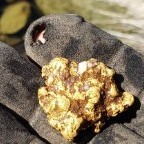
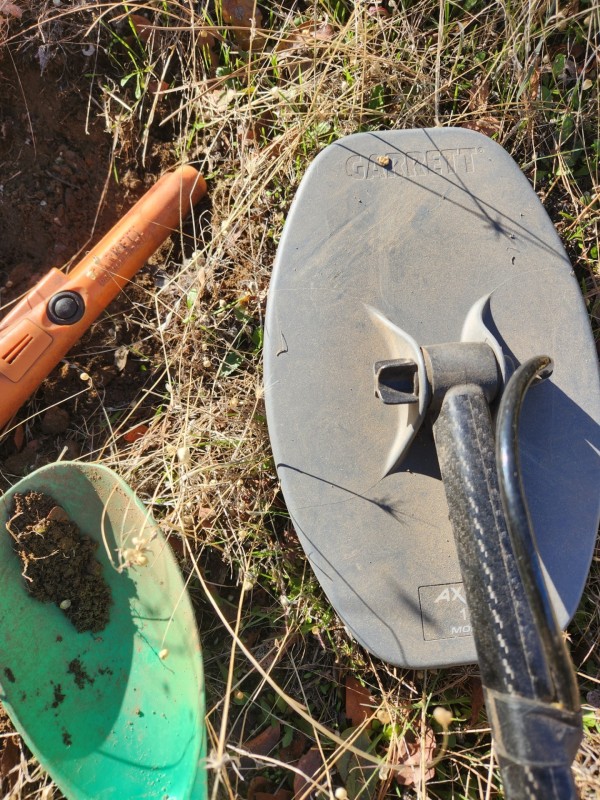
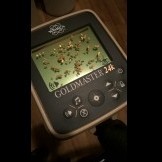
.thumb.jpg.77e4cb5bf39d44bdd2050d2edb7dfdb1.jpg)
